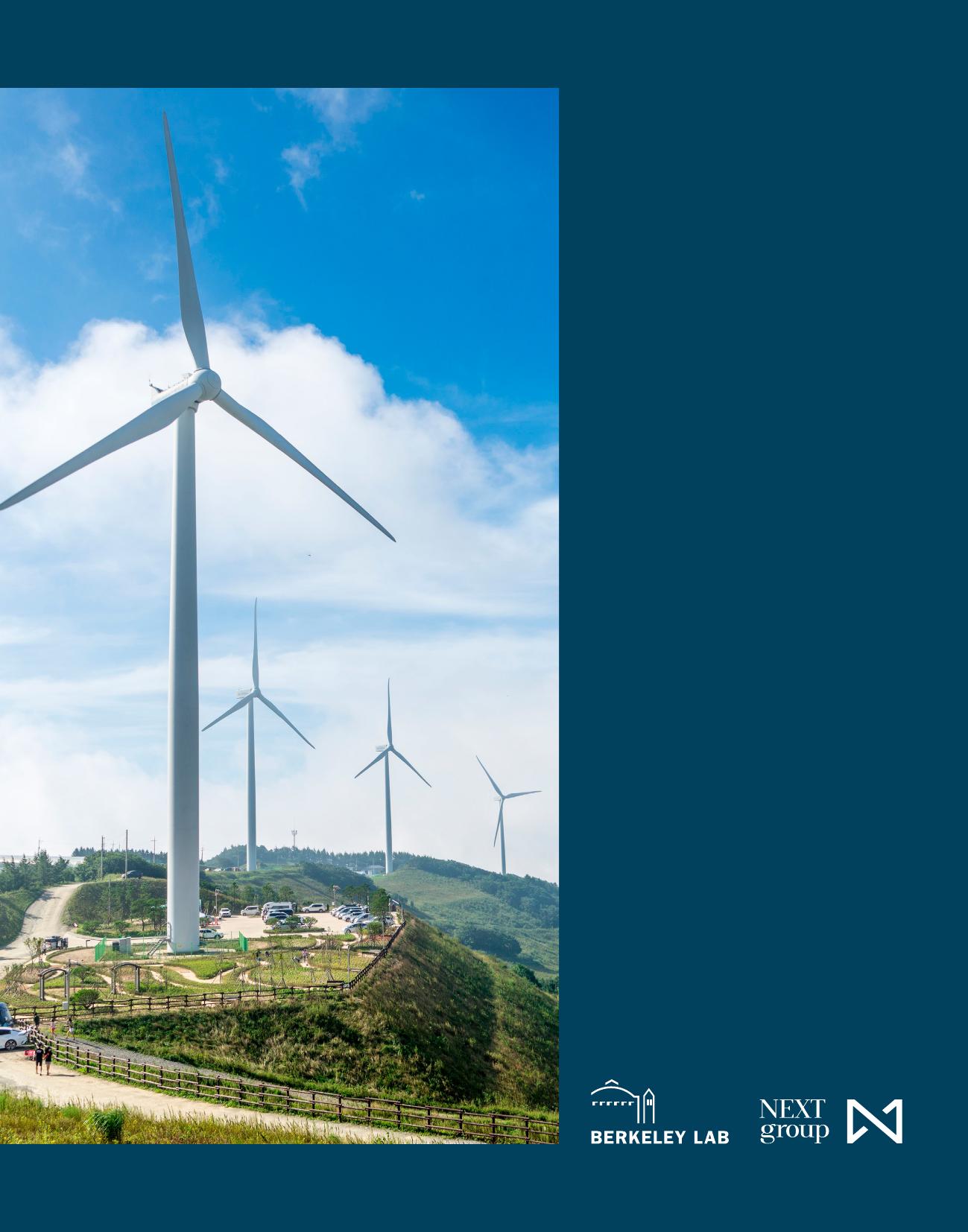ACleanEnergyACleanEnergyKoreaby2035Koreaby2035Transitioningto80%Carbon-FreeElectricityGenerationApril2023AUTHORSWonYoungPark1,NikitAbhyankar1,2,UmedPaliwal1,2,JamesHyungkwanKim1,NinaKhanna1,KenjiShiraishi1,2,JiangLin1,2,andAmolPhadke1,21�LawrenceBerkeleyNationalLaboratory,UnitedStatesofAmerica2UniversityofCalifornia,Berkeley,UnitedStatesofAmericaYongHyunSong3,HeeSeungMoon3,EunsungKim3,SanghyunHong3,andSeungWanKim3,43NEXTGroup,RepublicofKorea4ChungnamNationalUniversity,RepublicofKoreacorrespondingauthorLBNL-2001523ACleanEnergyKoreaby2035Transitioningto80%Carbon-FreeElectricityGeneration02ABSTRACTThecurrentglobalenergycrisishasmassiveimplicationsforthepeopleandeconomyofSouthKorea(Korea),whereatleast90%ofenergyusedependsonforeignfossilfuels.Cleanelectricityaccountsforonly39%oftotalgeneration,withelectricitydemandexpectedtoincrease30%by2035.ThisstudyshowsthatKoreacanachieve80%cleanelectricityby2035bycapitalizingonrapidtechnologicalimprovementsanddecreasingcostsofsolar,wind,andbatterytechnology.Doingsowouldslightlylowerelectricitysupplycosts,significantlyreducedependenceonimportednaturalgasandcoal,anddramaticallycutpowersectoremissions.Further,thisstudyfindsthatKorea’spowergridunderacleanenergyscenariowillmaintainreliabilitywithoutcoalgenerationornewnaturalgasplants.Torealizethesesignificanteconomic,environmental,andenergysecuritybenefits,policiessuchasan80%cleanelectricitystandardby2035andcorrespondingrenewableenergydeploymentgoalsarerequired.02ACleanEnergyKoreaby2035Transitioningto80%Carbon-FreeElectricityGeneration03DISCLAIMERWhilethisdocumentisbelievedtocontaincorrectinformation,neithertheUnitedStatesGovernmentnoranyagencythereof,norTheRegentsoftheUniversityofCalifornia,noranyoftheiremployees,makesanywarranty,expressorimplied,orassumesanylegalresponsibilityfortheaccuracy,completeness,orusefulnessofanyinformation,apparatus,product,orprocessdisclosed,orrepresentsthatitsusewouldnotinfringeprivatelyownedrights.Referencehereintoanyspecificcommercialproduct,process,orservicebyitstradename,trademark,manufacturer,orotherwise,doesnotnecessarilyconstituteorimplyitsendorsement,recommendation,orfavoringbytheUnitedStatesGovernmentoranyagencythereof,orTheRegentsoftheUniversityofCalifornia.TheviewsandopinionsofauthorsexpressedhereindonotnecessarilystateorreflectthoseoftheUnitedStatesGovernmentoranyagencythereof,orTheRegentsoftheUniversityofCalifornia.ErnestOrlandoLawrenceBerkeleyNationalLaboratoryisanequalopportunityemployer.COPYRIGHTNOTICEThismanuscripthasbeenauthoredbyauthorsatLawrenceBerkeleyNationalLaboratoryunderContractNo.DE-AC02-05CH11231withtheU.S.DepartmentofEnergy.TheU.S.Governmentretains,andthepublisher,byacceptingthearticleforpublication,acknowledges,thattheU.S.Governmentretainsanon-exclusive,paid-up,irrevocable,worldwidelicensetopublishorreproducethepublishedformofthismanuscript,orallowotherstodoso,forU.S.Governmentpurposes.TECHNICALREVIEWCOMMITTEEBelowarethemembersoftheTechnicalReviewCommittee(TRC).TheTRCprovidedinputandguidancerelatedtostudydesignandevaluation,but,thecontentsandconclusionsofthereport,includinganyerrorsandomissions,arethesoleresponsibilityoftheauthors.TRCmemberaffiliationsinnowayimplythatthoseorganizationssupportorendorsethisworkinanyway.YeoungjinChaeKoreaPowerExchange(KPX)JiyongEomKoreaAdvancedInstituteofScienceandTechnology(KAIST)WooyoungJeonChonnamNationalUniversitySiYoungLeeTechUniversityofKoreaHyeongonParkPukyongNationalUniversityDongjunWonInhaUniversityACKNOWLEDGEMENTSFundingwasprovidedbyClimateImperativeFoundation.Thefollowingpeopleprovidedinvaluabletechnicalsupport,input,review,andassistanceinmakingthisreportpossible.RanjitDeshmukhofUniversityofCaliforniaSantaBarbaraandLawrenceBerkeleyNationalLaboratoryKyeYoungLeeofNEXTGroupAnyaBreitenbachofForge&FoundryStrategicDanMullen03NEXTGroupisanenergyandclimatepolicythinktankdedicatedtoAsia'snet-zeroenergytransitions.ACleanEnergyKoreaby2035Transitioningto80%Carbon-FreeElectricityGeneration04CONTENTSTableofContentsABSTRACTDISCLAIMERCOPYRIGHTNOTICETECHNICALREVIEWCOMMITTEEACKNOWLEDGEMENTSListofTablesListofFiguresEXECUTIVESUMMARY02030303030505071.INTRODUCTION2.METHODSANDDATASUMMARY2.1.PolicyScenarios2.2.ModelingToolsandApproach2.3.KeyModelingInputs2.4.SensitivityAnalysis3.KEYFINDINGS3.1Generation,Transmission,andStorage3.2Cost,ReliabilityandEnvironmentalImpacts3.3SensitivityAnalysis4.CAVEATS5.CONCLUSIONSANDFUTUREACTIONSREFERENCESAPPENDIXAMODELINGAPPROACHAPPENDIXBMODELINGINPUTSAPPENDIXCSOLARANDWINDPROFILESAPPENDIXD�REGIONALRENEWABLEENERGYDEPLOYMENT1619192223293030343850515356586067ACleanEnergyKoreaby2035:Transitioningto80%Carbon-FreeElectricityGenerationACleanEnergyKoreaby2035Transitioningto80%Carbon-FreeElectricityGeneration0521282929Table1.PolicyScenariosBenchmarkedAgainstNationalGoalsTable2.CombinedModelingScenarioofPolicy,TechnologyCostsandFuelPricesTable3.OtherAssumptionsTable4.SensitivitiestoLow/HighTechnologyCosts,HighFuelPrices,andReliabilityTestsListofTables17222324262731323334Figure1.Long-termFuelPriceTrendsinKoreafrom2001to2022Figure2.GenerationResourcesandTransmissionNetworkIncludedintheModelingFigure3.Korea’sProjectedAnnualElectricityGenerationFigure4.�TechnologyCostInputsforOffshoreWind,Land-basedWind,SolarPV,andBatteryStorage(4-hour)Figure5.FuelPriceInputsforOilandGasFigure6.REPotentialand2035ProjectedElectricityDemandbyRegionFigure7.Korea’sElectricityGenerationMixThrough2035Figure8.Korea’sTotalInstalledCapacityThrough2035Figure9.TransmissionCapacityExpansionby2035inCurrentPolicyandCleanEnergyScenariosFigure10.�AnnualizedIncrementalCosts,IncrementalSavings,andNetSavingsintheCleanEnergyScenario,RelativetotheCurrentPolicyScenarioListofFiguresACleanEnergyKoreaby2035Transitioningto80%Carbon-FreeElectricityGeneration063536373839394041424243444546474849Figure11.CumulativeNewCapitalInvestmentforGenerationandTransmissionFigure12.CumulativeImportedFuelCostsforPowerGenerationFigure13.ElectricSectorEmissionsofCO2,SOX,NOXandPM2.5Through2035Figure14.NationalSystemAverageHourlyDispatchin2035,withCoalRetirementsFigure15.NationalSystemDispatchintheHighestNetLoadWeekinSummer2035Figure16.NationalSystemDispatchintheHighestNetLoadWeekinWinter2035Figure17.NationalSystemDispatchintheLowestNetLoadWeekinSpring2035Figure18.NationalSystemDispatchintheLowestLoadWeekinFall2035Figure19.��NationalSystemDispatchintheHighestNetLoadWeekinSummer2035,witha10%DemandShockFigure20.�NationalSystemDispatchintheHighestNetLoadWeekinWinter2035,witha10%DemandShockFigure21.�DailyNationalSystemDispatchAveragedOver7WeatherYearsintheCleanEnergyScenarioin2035Figure22.AnnualCapacityFactorofNaturalGasPlantsintheCleanEnergyScenarioin2035Figure23.AverageAnnualCapacityAdditions,CleanEnergyScenariowithBasevs.HighFuelPriceCasesFigure24.�GenerationMixandTotalInstalledCapacityBetween2022and2035,CleanEnergyScenariowithHighFuelPriceCaseFigure25.�CumulativeNewCapitalInvestmentinGenerationandTransmission,CleanEnergyScenariowithBasevs.HighFuelPriceCasesFigure26.�CumulativeIncrementalCostsofImportedFuelforPowerGeneration,CurrentPolicyvs.CleanEnergyScenarios,HighFuelPriceCaseFigure27.�AnnualElectricitySupplyCosts(TotalandPer-Unit),CleanEnergyScenario,Low/Base/HighREandStorageCostsListofFiguresACleanEnergyKoreaby2035Transitioningto80%Carbon-FreeElectricityGeneration07ThecurrentglobalenergycrisishasmassiveimplicationsforSouthKorea(Korea),whichdependsonforeignfossilfuelsforatleast90%ofitsenergyuse.Atthesametime,technologicaladvancementsanddramaticcostreductionsforsolar,wind,andbatterystoragecreatesignificantopportunitiestoreduceemissionsandcostsrelatedtoKorea’selectricitygeneration,betterpositioningthecountrytomeetits2050goalofcarbonneutrality.ThemostimportantdecarbonizationstrategyforKoreaistoincreaseitsshareofcleanelectricitygeneration–primarilyfromsolar-andwind-basedrenewableenergy(RE),butalsofromnuclearpowerplants.1In2022,cleangeneratingresourcesprovidedonly39%ofthecountry’stotalelectricitygeneration.Korea’snear-termgoalistoreach59%cleanelectricitygenerationby2036.2Thisstudyexaminesthefactorsinvolvedinhittingassociatedcost,reliability3,andemissionstargetswhiledramaticallyreducingtheuseoffossilfuelsinelectricitygeneration.Further,itaimstoinformdiscussionaroundKorea’scleanenergytransitionbyansweringthreevitalquestions:1�Hydrogenisalsoincludedasacleanenergysourcebutassessedtohavelowcost-competitivenessby2035.2�Basedonthe10thBasicPlanforLong-termElectricitySupplyandDemand.3�Theterm“reliability”referstothestable,consistentprovisionofelectricitybypowersystemsandhasaspecificmeaninginpowersystemstudies.Inthisstudy,wematchedthehourlyoperationalfeasibilityofKorea’spowersystem,consideringkeyoperationalconstraintssuchasrampinglimitsonthermalpowerplants,technicalminimumgenerationlevels,seasonalanddiurnalconstraintsonhydrodispatch,andconstraintsontransmission/transfercapacity.Wealsomaintainaminimumplanningreservemargininourcapacityexpansionmodeling,aswellasoperationalreserves(i.e.,spinning,loadfollowing,andregulation)duringtheproductioncostmodeling.Whileourmodelingisatanhourlyresolutionandstopsshortofafullreliabilityanalysis,itdoescapturethenecessaryelementsofareliabilityanalysisandthereforeweusetheterm“reliability”throughout.Moreover,thisstudy’scompanionpolicybrief,KoreanPowerSystemChallengesandOpportunities:PrioritiesforSwiftandSuccessfulCleanEnergyDeploymentatScale,didconductafullpowersystemreliabilityanalysisaddressingcharacteristics(e.g.,inertia,resourceadequacy)thatarenotconsideredhere.Allrecommendationsinbothreportsaremutuallyconsistent,andnoneconflictwiththepolicybrief’sreliabilityanalysis.07ACleanEnergyKoreaby2035Transitioningto80%Carbon-FreeElectricityGenerationEXECUTIVESUMMARYACleanEnergyKoreaby2035Transitioningto80%Carbon-FreeElectricityGeneration08•�Whateffectwillrecentdeclinesinwind,solar,andbatterystoragecostshaveonthepaceandscaleofrenewableresourcedevelopment?•�Whatcleanenergygoalsaretechnicallyandeconomicallyfeasible,giveninherentuncertaintiesaboutelectricitydemandgrowth,fossilfuelprices,andREandenergystoragecosts?•�Howcanafastertransitiontocleanenergydelivernotonlyenvironmentalandeconomicbenefits,butalsoreducesecurityrisksrelatedtodependenceonimportedfossilfuels?Thisstudyusesstate-of-the-artcapacityexpansionandhourlydispatchmodelstoexplorecleanenergydeploymentin2025,2030,and2035,andconsiderstwomainscenarios.TheCurrentPolicyscenariolimitsannualdeploymentofwindandsolargenerationtocurrentgovernmentgoals,reflectingthe2030nationallydeterminedcontribution(NDC)targets,2050carbonneutralitygoal,and10thBasicPlanforLong-termElectricitySupplyandDemand(10thBasicPlan4).TheCleanEnergyscenarioincreasesannualdeploymentofwindandsolargenerationtothemaximumfeasiblelevelsassumedinthisstudy,whicharedeterminedbyourmodelingandmayexceedexistinggoals.WealsoappliedmultiplesensitivityanalysestotheCleanEnergyscenario(e.g.,highandlowREandstoragecosts,highfossilfuelprices,andgridreliability).OurfindingsshowthatKoreacancost-effectivelydeployanadditional43GWofrenewableenergyby2035beyondCurrentPolicyrequirements–a31%increaseinREcapacitydeployed–inawaythatmaintainsareliableelectricitygrid.Accordingly,werecommendthatKoreaincreaseits2035deploymentgoalsforREandenergystoragetorealizesignificanteconomic,energysecurity,andenvironmentalbenefitswhileacceleratingprogresstowardcarbonneutralityandcombattingclimatechange.4�Korea’scomprehensivedocumentationofelectricityregulationsandplans,whichincludesthebasicprinciplesofelectricitysupplyanddemand,long-termforecasts,powersystemplanning,anddemand-sidemanagement.TheBasicPlanisupdatedeverytwoyears,mostrecentlyinJanuary2023,coveringtheperiodof2022-2036.ACleanEnergyKoreaby2035Transitioningto80%Carbon-FreeElectricityGeneration08ACleanEnergyKoreaby2035Transitioningto80%Carbon-FreeElectricityGeneration09KEYFINDINGSKorea’s80%CleanGridby2035isReliableWithoutCoalGenerationorNewNaturalGasPlantsTherehasbeenalongstandingdebateaboutwhetherKoreacouldreliablyoperateelectricitysystemswithhighpenetrationsofREgeneration.ThisstudyfindsthatintheCleanEnergyscenario,land-basedwind,offshorewind,andsolarphotovoltaic(PV)providehalfofelectricitygenerationby2035,whilenuclearpowerprovides30%foratotalof80%non-fossilfuelgeneration.IntheCleanEnergyscenario,usingbasecasefuelpriceassumptions(i.e.,basedon2012-2021trends),combinedREgenerationcapacityrisesto110GWin2030and182GWin2035,exceedingthegovernment’sgoalandproviding36%and50%oftotalelectricitygeneration,respectively.Offshorewindcapacityincreasesrapidlyinthisscenario,duetocontinueddeclinesintechnologycosts(FigureES1).Thecombinationofexistingnuclearcapacity,mostexistingnaturalgascapacity,andnewbatterystorageissufficienttomeetKorea’selectricitydemandreliably(i.e.,ineveryhouroftheyear)onan80%cleangridin2035.IntheCleanEnergyscenariowithbasefuelprices,allcoal-firedelectricitygenerationisphasedoutby2035andnonewfossilfuelplantsarebuilt.Undernormaloperatingconditions,RE,nuclear,andnaturalgasprovide50%,30%,and20%ofannualelectricitygeneration,respectively.Further,theCleanEnergyscenario’smixofelectricgeneratingresourcesissufficienttoreliablymeetsummerandwinterelectricitynetloadswhilemaintainingan8%operatingreservemargin.Additionally,upto37GWofexistingcoalgenerationcouldberetiredwithoutaffectingreliability.09ACleanEnergyKoreaby2035Transitioningto80%Carbon-FreeElectricityGenerationACleanEnergyKoreaby2035Transitioningto80%Carbon-FreeElectricityGeneration10FigureES1.GenerationEnergyMixandTotalInstalledCapacityBetween2022and2035,CleanEnergyScenariowithBaseFuelPriceCase10ACleanEnergyKoreaby2035Transitioningto80%Carbon-FreeElectricityGenerationHydroOffshoreWindFloatPumpedHydroStorageBioHeavyOilBatteryStorageNuclearSoftCoalSolarPVHardCoalLNGLand-basedWindOffshoreWindFixedOil80011%11%8%19%0%20%30%700600500400TWh30020010020222024202620282030203220340GW35036627272999252333002502001501005020222024202620282030203220340GenerationEnergyMixTotalInstalledCapacityACleanEnergyKoreaby2035Transitioningto80%Carbon-FreeElectricityGeneration11ElectricitySupplyCostsfromthe80%CleanGridareLowerThanToday’sCostsInboththeCurrentPolicyandCleanEnergyscenarios,underbasecaseassumptionsforREandstoragecosts,windandPVgenerationarethelowestcostandmostscalableREresources.IntheCurrentPolicyscenario,combinedwindandsolargenerationcapacityisconsistentwiththegovernment’sgoalofproducing21%(75GW)fromcleanenergysourcesby2030and35%(139GW)by2035.IntheCleanEnergyscenario,thecombinedwindandsolarcapacityrisesto36%ofelectricitygeneration(110GW)in2030and50%(182GW)in2035.Energystoragecapacityincreasesrapidlyinbothscenarios,duetocontinueddeclinesinbatterycosts(seeTableES1).TableES1.KeyDifferencesintheCurrentPolicyandCleanEnergyScenariosMetricYearCurrentPolicyScenarioCleanEnergyScenarioChangeincoalgenerationrelativeto20222030-98GWh-107GWh2035-173GWh-210GWhCoalgenerationcapacity203015GW15GW20358GW0GWCleanenergy(non-fossil)generationshare203055%71%203565%80%Windandsolargenerationcapacity203075GW110GW2035139GW182GWEnergystoragecapacity20308.5GW8.5GW203532.9GW42.3GW11ACleanEnergyKoreaby2035Transitioningto80%Carbon-FreeElectricityGeneration12Electricitysupplycosts,inclusiveofgenerationandtransmissioncosts,arelowerintheCleanEnergyscenario(inwhichwind,solar,andbatterystoragedisplaceasignificantamountofgenerationfromexistingcoalplants)thanintheCurrentPolicyscenario(inwhichgenerationfromexistingcoalplantsdeclinesbyonlyasmallamount).Inotherwords,theincrementalcostofdevelopingnewsolarandwindfarms,batterystorage,andtransmissioninfrastructureintheCleanEnergyscenarioislowerthanthefossilfuel,operationandmaintenance(O&M),andfixedcostsofrunningexistingcoal-firedplants(FigureES2).Thissuggeststhatamorerapiddeploymentofwindandsolargeneration–uptoanaverageof14.5GWperyearbetween2030and2035intheCleanEnergyscenario–wouldreduceelectricitysupplycosts.Retainingnaturalgas-firedpowerplantshelpsbalanceseasonalanddailyloadvariationsagainstvariablesolarandwindgeneration,therebyreducingtheneedforlong-durationenergystorageandfurtherrenewableplantbuildout.FigureES2.AnnualizedIncrementalCosts,IncrementalSavings,andNetSavingsintheCleanEnergyScenario,RelativetotheCurrentPolicyScenario12ACleanEnergyKoreaby2035Transitioningto80%Carbon-FreeElectricityGeneration420-2-4-6AnnualizedCost,TrillionKRW/YearIncrementalCostsIncrementalSavingsNetSavingsHydroLand-basedWindOffshoreWindFloatBatteryStorageTransmissionLineNetBioHeavyOilSolarPVOffshoreWindFixedPumpedHydroStorageNuclearHardCoalOilSoftCoalLNGACleanEnergyKoreaby2035Transitioningto80%Carbon-FreeElectricityGeneration13ScalingUpRenewablestoAchievean80%CleanGridIsFeasibleUndertheCleanEnergyscenario,thecombinedcapacityofallREsourcesrisesfrom26GWin2022to110GWin2030and182GWin2035(FigureES1).Inparticular,theacceleratedgrowthofwindandsolarcapacitymakesan80%cleangridfeasible.Solarpoweradditionsaredominantinthe2020s,whileoffshorewindbecomesdominantinthe2030sduetoitscontinuedtechnologycostdeclinesandhighcapacityfactors.An80%CleanGridBolstersKorea’sEnergySecuritybySignificantlyReducingFossilFuelImportsUnderthe80%CleanEnergyscenario,importedcoalandnaturalgascostswoulddecreasebyupto62%,from48.1trillionKRWin2022to18.5trillionKRWin2035.Thisreductionwouldbeevengreaterunderthehighfuelcostsensitivityscenario,whichmaintains2022prices.MaximizingtheutilizationofdomesticrenewableresourcessignificantlydecreasesKorea’sheavydependenceonimportedfossilfuels,inturnbolsteringitsenergysecurityandinsulatingconsumersandtheeconomyfromtheriskofskyrocketinginternationalfossilfuelprices.FigureES3.ImportedFuelCostsforPowerGenerationintheCleanEnergyScenario13ACleanEnergyKoreaby2035Transitioningto80%Carbon-FreeElectricityGenerationTrillionKRW4030201002022202420262028203020322034SoftCoalLNGACleanEnergyKoreaby2035Transitioningto80%Carbon-FreeElectricityGeneration1414AchievingCleanEnergyGoalsDramaticallyReducesEmissionsofCO2andOtherAirPollutantsReachingan80%cleanelectricitygridby2035woulddeliverdeepcutsincarbonemissions,alongwithotherenvironmentalbenefits.By2035,theCleanEnergyscenarioreduceselectricitysectorcarbondioxide(CO2)emissionsby76%below2022levels,and52%belowtheCurrentPolicyscenario.Similarly,emissionsofnitrogenoxides(NOX),sulfuroxides(SOX),andfinedust(PM2.5)fallby46%,100%,and69%,respectively.Electrificationofthetransportation,industrial,andbuildingssectorswouldreduceemissionsevenfurther.FigureES4.ElectricitySectorEmissionsofCO2,SOX,NOXandPM2.5Through2035ACleanEnergyKoreaby2035Transitioningto80%Carbon-FreeElectricityGenerationCurrentPolicyScenarioCleanEnergyScenarioCO2CO2emillionTonne25020015010005002022202420262028203020322034SOxTonne40,00030,00020,00010,00002022202420262028203020322034NOxTonne60,00050,00040,00030,00020,00010,00002022202420262028203020322034PM2.5Tonne20,00015,00010,0005,00002022202420262028203020322034ACleanEnergyKoreaby2035Transitioningto80%Carbon-FreeElectricityGeneration15CapturingAllAvailableCost-EffectiveCleanElectricityGenerationRequiresOvercomingPolicy,Market,andLandUseBarriersRapiddeploymentofwind,solar,andenergystoragetechnologieswillrequirechangesinpoliciesthatregulateelectricitygeneration,markets,andlanduse.Theaccompanyingreport,KoreanPowerSystemChallengesandOpportunities:PrioritiesforSwiftandSuccessfulCleanEnergyDeploymentatScale,discussesthesebarriersandpossiblepolicypathwaysingreaterdetail.TheshareofcleanenergygenerationintheCurrentPolicyandCleanEnergyscenariosbeginstodivergeinthe2022-2025timeperiod,suggestingthatpolicyandregulatorychangestoaccelerateREdeploymentshouldbegininthe11thBasicPlanperiod(2024-2038).Inparticular,whilemomentummayalreadysupporttheaccelerateddeploymentofwindandsolarenergy,significantbarriersstillimpedeenergystoragedeployment.FasterdecarbonizationofKorea’selectricitysystemwould,inturn,makeelectrificationavailabletosupportCO2emissionreductionsinothersectors,smoothingthecountry’spathtoacarbon-neutraleconomyby2050.15ACleanEnergyKoreaby2035Transitioningto80%Carbon-FreeElectricityGenerationACleanEnergyKoreaby2035Transitioningto80%Carbon-FreeElectricityGeneration16InOctober2018,theUnitedNationsIntergovernmentalPanelonClimateChange(IPCC)reportedthatglobalcarbonemissionsmustbehalvedby2030tolimitwarmingto1.5°Candavoidcatastrophicclimateimpacts(IPCC2018).InOctober2020,Korea–theworld’seleventhlargestgreenhousegas(GHG)emitter–pledgedtobecomeclimateneutralby2050(UNFCCC2021).Oneyearlater,theKoreangovernmentadoptedanenhancednationallydeterminedcontribution(NDC)targetfor2030toreduceemissions40%below2018levels.WhileKorea’scommitmentscancontributetoglobalclimategoals,theKoreanNDCtargetfor2030–whichreliesoninternationalcarboncredits,aswellascarboncapture,utilizationandstorage(CCUS)–isinsufficientandincompatiblewiththe1.5°CtargetsetforthbytheParisAgreement(GESIetal.2022).Inaddition,whiletargetsareimportant,aconcreteimplementationpathwayforKorea,supportedbysoundpolicyinstruments,hasbeenlacking.161.INTRODUCTIONACleanEnergyKoreaby2035Transitioningto80%Carbon-FreeElectricityGeneration17Technologicaladvancementsanddramaticcostreductionsinsolar,wind,andbatterystoragecreatenewopportunitiestoreduceemissionsandcostsrelatedtoelectricitygenerationinmanycountries(seeShiraishietal.2023;Bistlineetal.2022;Abhyankaretal.2022;Abhyankaretal.2021;Phadkeetal.2020fortheU.S.,China,andIndia).TheelectricitysectorwillplayapivotalroleinmeetingKorea’senvironmentalgoals,includingboththe2050carbonneutralityand2030NDCgoals.Increasesinnon-fossilgeneration,combinedwithelectrificationinthetransportation,industrial,andbuildingsectors,cangeneratesignificantreductionsinemissions.Severalstudieshaveanalyzedthepowersector’stransitiontoREanddecarbonizationinKorea.Parketal.(2013)exploreddifferentscenariosforachievingthistransitionby2050,concludingthatamixofREsourcesFigure1.Long-termFuelPriceTrendsinKoreafrom2001to2022Long-termfuelpricetrendsinKoreaarehighlyuncertain,inthatoilandgaspricesrosetorecordlevelsin2011,andagainin2022–inthelattercase,by109%comparedtoaveragepricesoverthepriordecade(Figure1).In2020,only7%ofKorea’sprimaryenergywassuppliedbydomesticresources(KEEI2021).Liquifiednaturalgas(LNG)andcoalpowerplantsstillaccountforroughly64%ofthenation’selectricitygeneration,exposingconsumersandtheoveralleconomytohighlyvolatileinternationalfuelprices.Source:EPSIS(2023)KRW/kWh40035030025020015010050020012006201120162021HardCoalLNGSoftCoalOilACleanEnergyKoreaby2035Transitioningto80%Carbon-FreeElectricityGeneration18isnecessarytoachievesignificantreductionsinGHGemissions.Songetal.(2018)analyzedvariousenergytransitionstrategiesusingapowermarketsimulationmodel,identifyingphasingouteithernuclearenergyorcoal(butnotboth)asviableoptions.Parketal.(2019)evaluatedREpotentialscenarios,suggestingaweather-drivenhourlysimulationscenariocanmeetemissiontargetsby2030withreducedcoalgeneration.Kimetal.(2022)analyzedtechnologypathwaysforachievingcarbonneutralityby2050,emphasizingrapiddecarbonizationofthepowersectorandtheelectrificationofend-uses.ThesefindingsprovidevaluableinsightsintothechallengesandopportunitiesfortransitioningtocleanenergyanddecarbonizationinKorea.However,fewornostudieshaveexaminedaccelerateddecarbonizationpathwaysforKorea’spowersector,particularlyfora2035timehorizon,byusingcapacityexpansionandhourlydispatchmodels5andincorporatingrapidlydecreasingtechnologycosts.Thisreportaimstoinformdiscussionaroundthreequestionspriorstudieshavenotaddressed.First,whateffectwillrecentdeclinesinwind,solar,andbatterystoragecostshaveonthepaceandscaleofrenewableresourcedevelopmentinKorea?Second,whatcleanenergygoalsaretechnicallyandeconomicallyfeasible,giveninherentuncertaintiesaroundelectricitydemandgrowth,fossilfuelprices,andREandenergystoragecosts?Third,howcanafastertransitiontocleanenergydelivernotonlyenvironmentalandeconomicbenefits,butalsoreducesecurityrisksrelatedtodependenceonimportedfossilfuels?Thisreportexaminesthetechnicalfeasibility,costs,andimplicationsofincreasingtheshareofelectricitygeneratedfromcleanenergyinKoreato80%by2035.Theanalysisusesstate-of-the-artmodelingtoolsalongwithdetailedload,wind,andsolarprofilesandwind,solar,andenergystoragecostprojections.Section2ofthisreportprovidesanoverviewofthemethodsusedintheelectricityandemissionsanalyses,whileSection3describestwocategoriesofresults:(1)changesingenerationandtransmission,and(2)cost,investment,reliability,andemissions.Section4describescaveatsforthisanalysis.Section5summarizeskeyconclusionsfromthestudy.Appendicesprovidemoredetailedinformationonthemodelingapproach,datainputsandsources,loadshapedevelopment,andwindandsolarprofiledevelopment.Theaccompanyingreport,KoreanPowerSystemChallengesandOpportunities:PrioritiesforSwiftandSuccessfulCleanEnergyDeploymentatScale,discussesthesebarriersandpossiblepolicypathwaysingreaterdetail.5�Capacityexpansionmodelsareusedtodeterminetheoptimalmixofenergysourcesrequiredtomeetenergydemandwhileminimizingcostsandemissions.Hourlydispatch(orproductioncostoptimization)modelshelptodeterminethemostefficientandcost-effectivewaytodispatchelectricityfromdifferentenergysourcesthroughouttheday.ACleanEnergyKoreaby2035Transitioningto80%Carbon-FreeElectricityGeneration19Thisstudydrawsonintensivescenariobuilding,datadevelopment,andpowersystemmodelingusingdetailed,best-availabledatainputsandstate-of-the-artmodelingtools.AnalysesfoundinthisreportusecapacityexpansionandhourlydispatchmodelsdevelopedinthePLEXOSplatformtoforecasttheyears2025,2030,and2035.ThemodelsarebasedonadetailedrepresentationofKorea’selectricitysystem,includinghourlyregionalloads,interregionaltransmissionconstraints,region-specificwindandsolarprofiles,andrecentREandelectricitystoragecostprojections.TheelectricitydemandforecastusedintheanalysisisbasedonKoreangovernmentprojectionsandreflectsnecessarychangesintheelectricitysystemtomeet2050climategoals.Thissectionprovidesabriefoverviewofscenarios,keyinputsandassumptions,modelingtoolsandapproach,andsensitivityanalyses.TheAppendicesincludedetaileddescriptionsofmethodsusedformodelingandthedevelopmentofhourlyload,wind,andsolarprofiles.2.1PolicyScenariosTheanalysisexaminestwocorescenarios.TheCurrentPolicyscenarioreflectscurrentpolicies(i.e.,2030NDCtargets,2050carbonneutralitygoal,andthe10thBasicPlan)andtechnologycosttrendsinKorea,leadingtoacleanenergygenerationshareof65%in2035.6IntheCleanEnergyscenario,where80%ofelectricityisgeneratedfromcleansourcesin2035,weexaminewhetherthisadditionalcleanenergydeploymentisachievable,costeffective,andwouldmaintainareliableelectricitygrid.SensitivityanalysesexplorevariationsintheCleanEnergyscenario.6�Thisisalittlegreaterthan59%cleanelectricitygenerationby2036inthe10thBasicPlan.2.METHODSANDDATASUMMARYACleanEnergyKoreaby2035Transitioningto80%Carbon-FreeElectricityGeneration20TheCurrentPolicyandCleanEnergyscenariosdiffermainlyintheirassumptionsaboutcoalgenerationcapacityadditions,REgenerationcapacityadditions,andnon-fossilenergygenerationshare(Table1).First,theCurrentPolicyscenarioforcesanet5.4GWofcoalgenerationcapacityadditionsintothemodel,basedonplantscurrentlyunderconstructionandsomeretirementofexistinggeneration;italsoassumestheextendedoperationof10nuclearreactorstotaling11.25GWofemissions-freegeneratingcapacity,basedonaplanunderconsideration.TheCleanEnergyscenariodoesnotforcethisnet5.4GWofcoalgenerationintothemodel,butratherforcesthephase-outofcoal-firedpowergenerationby2035.Second,theCurrentPolicyscenarioassumestheamountofnewwindandsolargenerationthatcanbeaddedinanygivenmodelyearislimitedtotheamountrequiredtomeetcurrentpolicytargetsandtheirimpliedtrajectoriesin2035.IntheCleanEnergyscenario,theselimitsarerelaxed,andnewwindandsolargenerationcapacityadditionsaredeterminedbasedontheireconomiccompetitivenesswithintheirannualinstallationcapacitylimits.Lastly,intheCurrentPolicyscenario,themodelbuildsnon-fossilgenerationtoprovide55%ofgenerationin2030and65%in2035.Incontrast,theCleanEnergyscenariohasnoconstraintsonnon-fossilgeneration.ACleanEnergyKoreaby2035Transitioningto80%Carbon-FreeElectricityGeneration21Table1.PolicyScenariosBenchmarkedAgainstNationalGoalsNATIONALGOALS2035SCENARIOSDEVELOPEDINTHISREPORTCURRENTPOLICYSCENARIOCLEANENERGYaSCENARIOReferencepolicies/plans•�New2030NDCTarget•�2050CarbonNeutralityGoal10thBasicPlanforLong-termElectricitySupplyandDemand(10thBasicPlan)•Nationalgoals•NuclearextensionCoalgenerationcapacityadditions5.4GW4.2GW5.4GW•�Nonewcoalgenerationisforcedintothemodel.•�Coalgenerationisphasedoutby2035.REgenerationcapacityadditionsRE~30%ingenerationshareby2030(70GWsolarand22.5GWwindcapacity)RE~25%ingenerationshareby2036(65.7GWsolarand34GWwindcapacity)LimitedtoREdeployment(21%in2030and35%in2035)andemissionreductiontargetsby2035Determinedtomeetemissionreductiontargetsby2035andcostcompetitivenessClean(non-fossil)energygenerationshare57.7%by2030•RE30.2%•Nuclear23.9%•NH33.6%59.3%by2036•RE24.7%•Nuclear34.6%55%in203065%in2035Determinedbymodel’sleast-costoptimizationNuclearextensionNotincluded•10nuclearreactors(11.25GW)operationextended•2newnuclearreactors(2.8GW)addedin2033and2034H2orNH3NH33.6%(2030)7.1%bH2included(determinedbymodel’sleast-costoptimization)Electricitygenerationprojected612.4TWhin2030,1257TWhin2050667.3TWhin2036612.4TWhin2030776.6TWhin2035a�CleanenergyinthisreportrefersprimarilytoRE(solar,wind,hydroandmarineenergy)andnuclear.Biofuel,fuelcell,integratedgasificationcombinedcycle(IGCC)arenotincludedbecausetheyarenotdefinedascleanenergy.bH2andNH3inthe10thBasicPlanarenotassuredtobegreenorblue.cSeeFigure2Sources:MOTIE(2023),CNC(2021),andUNFCCC(2021)ACleanEnergyKoreaby2035Transitioningto80%Carbon-FreeElectricityGeneration222.2ModelingToolsandApproachTheelectricitysystemanalysiswasconductedusingPLEXOS,amodelingplatformwidelyusedforindustry-standardpowersystemsanalysis.Atwo-stagemodelingapproachwasusedtodevelopleast-costportfoliosforeachscenario,andthenexamineoperatingcosts,emissions,andreliabilitybasedondirectcurrent(DC)powerflows.Modelsincludedgenerationresources,generationconstraints,unitcommitments,andinterregionaltransmissionconstraintsfor11nodesconnectedby17interregionaltransmissioncorridors(Figure2).Thisanalysisassumedtheelectricitysystemwasbalancedandreservesweremanagedataregionalscale,enablingresourcestobesharedefficientlyamongprovinces.Figure2.TransmissionNetworkIncludedintheModelingOrangedashlinesrepresentvirtuallyestablishedWestCoasttransmissionlinesinthemodel(seeTable3),whileblacklinesrepresentexistingtransmissionlines.Source:Authors’work.GangwonGyeongbukBusan/UlsanSeoul/GyeonggiIncheonChungnamChungbukJeonbukJeonnamJeju7GW5GW3GW1GWGyeongnam(Slack)ACleanEnergyKoreaby2035Transitioningto80%Carbon-FreeElectricityGeneration23Figure3.Korea’sProjectedAnnualElectricityGeneration2.3.KeyModelingInputsElectricityDemandKorea’selectricitydemandisexpectedtogrowby2035andwilldependonthestructureandpaceofeconomicgrowth,aswellasthepaceofelectrificationinthetransportation,industry,andbuildingssectors.Thisstudyisbasedongovernmentprojectionsusedwiththe2030NDCand2050CarbonNeutralitygoals.Source:MOTIE(2023)andUNFCCC(2021)TWh800750700650600550500201920212023202520272029203120332035612621659774CurrentScenarioandCleanEnergyScenariousedinthisstudyThe10thBasicPlanforLong-termElecticitySupplyandDemand24ACleanEnergyKoreaby2035Transitioningto80%Carbon-FreeElectricityGenerationTechnologyandFuelCostsExtensiveresourcecostinputsincludedthoseforwind,solar,andbatterystorage,aswellascoalandgasfuel.Annualtechnologybase(ATB)scenariosfromtheNationalRenewableEnergyLaboratory(NREL)providedprojectionsofinstalledandfixedoperationsandmaintenance(O&M)costsforland-basedwind,offshorewind,solarPV,andstorageintheU.S.Phadkeetal.(2020)emphasizedthatrapid,cost-effectivedecarbonizationbecomesmoreachievablebecauseofthesignificantaccompanyingdecreaseincostsandcostprojectionsforwindandsolarenergy.TheypointedoutthatNRELATB’sprojectionsintermsoflevelizedcostofelectricity(LCOE)werereviseddownwardsalmosteveryyearbetween2015and2019.Becausetechnologicaladvancementsoccuralongsideuncertainty,thetechnologycosts(Low,Base,andHigh)forKorea’sREandstorageinthisstudyarebasedonLee&Kim(2020)forbaselinecostsin2020thatarelaterassumedtoconvergeonNRELATB’sAdvancedscenarioin2030(Low),Moderatescenarioin2035(Base),andConservativescenarioin2035(High).Themodelalsoconsiders4-hour,8-hour,and12-hourbatterystoragedurations,whichallhavecostdeclinessimilartothosefor4-hourbatteries(Figure4).Figure4.TechnologyCostInputsforOffshoreWind,Land-basedWind,SolarPV,andBatteryStorage(4-hour)OFFSHOREWINDCOSTS(FIXEDBOTTOM)NRELATB2022AllScenariosKoreaLowKoreaBaseKoreaHigh60005000400030002000100001000KRW/kW2020202120222023202420252026202720282029203020312032203320342035OFFSHOREWINDCOSTS(FLOATING)NRELATB2022AllScenariosKoreaLowKoreaBaseKoreaHigh1000080009000700060005000400030002000100001000KRW/kW202020212022202320242025202620272028202920302031203220332034203525ACleanEnergyKoreaby2035Transitioningto80%Carbon-FreeElectricityGenerationFigure4.TechnologyCostInputsforOffshoreWind,Land-basedWind,SolarPV,andBatteryStorage(4-hour)SOLARPVCOSTSNRELATB2022AllScenariosKoreaLowKoreaBaseKoreaHigh1800140016001200100080060040020001000KRW/kW2020202120222023202420252026202720282029203020312032203320342035NRELATB2022AllScenariosKoreaLowKoreaBaseKoreaHigh20202021202220232024202520262027202820292030203120322033203420353000250020001500100050001000KRW/kWLAND-BASEDWINDCOSTSUTILITY-SCALEBATTERY(4-HR)COSTSNRELATB2022AllScenariosKoreaLowKoreaBaseKoreaHigh020202021202220232024202520262027202820292030203120322033203425002000150010005001000KRW/kW203526ACleanEnergyKoreaby2035Transitioningto80%Carbon-FreeElectricityGenerationLonger-termfuelpricetrendsinKoreaarehighlyuncertain.Oilandgaspricesrosetorecordlevelsinboth2011and2022.Coalsupplyanddemandtendtokeeppricesclosetomarginalproductionandtransportcosts.Thisstudy’sHighFuelscenarioassumesKorea’saverage2022fuelpricesremainconstantuntil2035,whereastheBaseFuelscenarioassumespricesdeclineto2001-2021averages(EPSIS2023)until2027beforeincreasingtoreflecttheU.S.AnnualEnergyOutlook(AEO)ReferenceScenarioforecast(EIA2022).TheCurrentPolicyandCleanEnergyscenariosusethesametechnologycostandfuelcostassumptions(Figure5).Figure5.FuelPriceInputsforOilandGasNuclearSoftCoalHardCoalOilLNGBaseFuelPriceKRW/GJ30,00025,00020,00015,00010,0005,00035,00040,000020212023202520272023203120332035HighFuelPriceKRW/GJ30,00025,00020,00015,00010,0005,00035,00040,00002021202320252027202320312033203527ACleanEnergyKoreaby2035Transitioningto80%Carbon-FreeElectricityGenerationSolarandWindProfilesForthisstudy,weestimatedwindandsolarresourcepotentialanddevelopeddetailedsolarandwindprofilesforeachprovinceinKorea.Themethodologycanbedividedintotwoparts,thefirstofwhichinvolvesestimatingtheresourcepotential(i.e.,themaximumsolarandwindcapacitythatcanbeinstalledinaprovince).WeuseaverageannualcapacityfactorsfromtheGlobalWindandSolarAtlasandapplymultipleexclusioncriteria(e.g.,elevation,slope,landcover,naturalparks,defenseareas,fisheryzonesandoceandepth)toestimatethepotentialforbothsolarandwind.Thesecondpartofthemethodologyinvolvesdevelopingdetailedhourlygenerationprofiles.Forthis,weusemeteorologicaldatafromreanalysisdatasetsandsimulatesite-levelwindandsolargenerationusingNREL’sSystemAdvisorModel(SAM)(NREL2017).TypicalwindandsolarfarmsaredesignedinSAM,andhourlygenerationisestimatedbypassingmeteorologicaldatathroughit.Wethenuseanaggregationalgorithmtocombinehourlygenerationfrommultiplesitesinagivenprovincetocreatearepresentativeprovincialwindandsolarresourceprofile.Foroffshorewind,wedevelopmultipleclustersforfixedandfloatingwindprojectsusingaspatiallyconstrainedmultivariateclusteringalgorithm,andthendevelopprofilesforeachcluster.OurcompletemethodologyanddatasourcesarediscussedindetailinAppendixC.Figure6.REPotentialand2035ProjectedElectricityDemandbyRegionSolarPVOnshoreWTOffshoreWT(Fixed)OffshoreWT(Floating)Demand3001000100300TWh5007009001100JejuBusan/UlsanGyeongnamJeonnamJeonbukGangwonDaegu/GyeongbukChungnamChungbukIncheonSeoul/Gyeonggi28ACleanEnergyKoreaby2035Transitioningto80%Carbon-FreeElectricityGenerationNuclearGenerationBecausenucleargeneratingcapacityisoftenbuiltforreasonsotherthaneconomics,thisstudyassumedanucleargenerationcapacitythatisbasedonpolicytargets,ratherthancost.Itwasassumedthatnucleargenerationcapacitywouldincreaseasaresultofa20-yearlifetimeextensionof10nuclearreactorstomeetthepolicytargetof32.8%(11.25GW)inthe2030generationmix.ItwasalsoassumedthatShin-HanulUnits3and4,having1.4GWcapacityeach,wouldbeaddedin2033and2034,respectively.ModelingScenariosTable2showsthetwocoremodelingscenariosconsideredinthisstudy,includingpolicy,technologycost,andfuelpriceassumptions,whileTable3summarizesotherassumptionsusedinthisstudy.Table2.CombinedModelingScenarioofPolicy,TechnologyCostsandFuelPricesPolicyRE&StorageCostsFuelPricesTwocoremodelingscenariosCurrentPolicy(reflectinggovernmentplans:2030NDCtarget,2050CarbonNeutralityGoal,and10thBasicPlan)BasecaseBasecaseCleanEnergy29ACleanEnergyKoreaby2035Transitioningto80%Carbon-FreeElectricityGenerationTable3.OtherAssumptionsParameterAssumptionsCoalretirementsExistingcoal-firedplantsretireattheendoftheir30-yearlifetimes.InCleanEnergyScenario,decreasingtheamountofcoalgenerationeachyear,untilcoalgenerationiscompletelyphasedoutin2035.GasretirementsExistinggas-firedplantsretireattheendoftheir30-yearlifetimes.NuclearextensionExistingnuclearplantsextendtheirlifetimesbyrenewingtheirgenerationlicensesby20yearsattheendoftheir40-or60-yearlifetimes.TransmissionexpansionScenariosexploredtheoutcomesofincreasingtransmissionlinecapacity.SolarPVSolarPVfacilitiesretireuponreachingtheir25-yearlifetimesandrealizeanaveragecapacityfactor(CF)of17%.WindturbinesWindturbinesretireuponreachingtheir25-yearlifetimesandrealizeaverageCFsof24%(land-based)and36%(offshore).MaximumannualcapacityexpansionAnnualdeploymentofsolarPV,land-basedwind,andoffshorewindislimitedto6GW,2GW,and6.5GW,respectively,basedonexpertconsultation.TransmissionexpansionStartingin2026,newtransmissionlineswithacapacityof2.5GWbetweenregionsareallowed.Additionally,transmissionlineswithacapacityof7GWareestablishedthatconnecttheSeoulmetropolitanareatotheJeonbuk,Jeonnam,andJejuregions(seeorangelines,Figure2).Table4.SensitivitiestoLow/HighTechnologyCosts,HighFuelPrices,andReliabilityTestsParameterAssumptionsREandstoragecostsLow(Advanced)andHigh(Conservative)casesFuelpriceHighfuelprices(at2022levels),resultingin1GWmoreREdeploymentperyear(withsolarPVrisingfrom6to6.5GWandoffshorewindrisingfrom6.5to7GW)ReliabilityDeterministicwindandsolargenerationandloadprofilesweresubjectedtoprolongedperiodsoflowwindandsolargenerationandanunanticipateddemandshockof10%aboveforecastCompletemethodologyanddatasourcesarediscussedindetailinAppendixB.2.4.SensitivityAnalysisTheanalysisconsideredfourmainsensitivities:lowandhighREandstoragecosts;highfuelprices;andreliability(Table4).30ACleanEnergyKoreaby2035Transitioningto80%Carbon-FreeElectricityGenerationThestudy’skeyfindingsarepresentedintwosections.Section3.1describesfindingsaboutgenerationmix,generationcapacitymix,generationcapacityadditions,transmissioncapacity,andcoalplantoperations.Section3.2outlinesfindingsaboutelectricitysupplycosts,totalinvestment,emissionreductions,andreliability.AdditionaldetailscanbefoundintheAppendices.3.1Generation,Transmission,andStorageAn80%CleanGridIsReliableWithoutCoalPlantsorNewNaturalGasPlants–EvenwithConsiderableElectricityDemandGrowthEvenaccountingforprojectedelectricitydemandgrowththrough2035,an80%cleangridisreliable,meaningthatitprovidesadequateenergyineveryhouroftheyeartomeetdemand.Windandsolarprovideabouthalfofdailygeneration,whilenuclearprovidesanadditional30%.UndertheCleanEnergyscenario,existinghydropowerandnuclearcapacityareretained(exceptforplannedretirements),allexistingcoalplantsareretiredby2035,andnonewfossilfuelplantsarebuilt.Duringperiodsofveryhighdemandorverylowrenewablegeneration,existingnaturalgas,andnuclearplantscombinecost-effectivelywithbatterystoragetocompensateformismatchesbetweendemandandwindandsolargeneration.Overall,naturalgasplantswouldprovideabout20%oftotalannualelectricitygeneration,comparedtoabout32%today.IntheCurrentPolicyscenario,cleanenergygenerationincreasesfrom35%oftotalgenerationin2022to65%in2035,andaccountsforallnewgeneratingcapacity.IntheCleanEnergyscenario,cleanenergygenerationreaches80%in2035.TheincrementalincreaseincleanenergyintheCleanEnergyscenarioisrealizedbyexpandingland-basedwind,offshorewind,andsolarPV(Figure7).3.KEYFINDINGS31ACleanEnergyKoreaby2035Transitioningto80%Carbon-FreeElectricityGenerationFigure7.Korea’sElectricityGenerationMixThrough2035ElectricityDemandCanBeMetWithoutAdditionalCoal-FiredGenerationIntheCurrentPolicyscenario,allnewgenerationcapacityadditionsarecleanenergyresources,asidefrom5.4GWprovidedbycoal-firedgeneratorsunderconstructionand2.5GWfromLNGgeneratorsinstalledin2035(Figure8).Windandsolargenerationcapacityreaches75GWin2030intheCurrentPolicyscenario,inlinewiththegovernment’s67.5GWtargetfor2030,andthenincreasesto139GWin2035.DecliningcostsleadtorapidincreasesinenergystoragedeploymentintheCurrentPolicyscenario,withatotalof8.5GWby2025and32.9GWby2035.IntheCleanEnergyscenario,windandsolargenerationandbatterystoragecapacityincreasemorerapidlythanintheCurrentPolicyscenario(Figure8).Divergenceofthetwoscenariosbeginsinthe2022-2025timeframe:renewablecapacityreaches50GWby2025intheCleanEnergyscenario,comparedtojust38GWintheCurrentPolicyscenario.Windandsolarcapacitygrowsto110GWby2030and182GWby2035intheCleanEnergyscenario,37%higherthanrequiredbycurrentpolicytargets.By2035,energystoragegrowsto42.3GWintheCleanEnergyscenario.Coal-firedpowerplantoperationschangesignificantlyinboththeCurrentPolicyandCleanEnergyscenarios,withsteepdeclinesinannualoperatinghoursandincreasesinthevariabilityofthosehours.IntheCurrentPolicyscenario,averageannualoperatinghoursforcoalplantsfallfrom7,800hoursperyear(80%capacityfactor)in2022to6,250hoursperyear(59%capacityfactor)in2035.IntheCleanEnergyscenario,thesefiguresfalltozero.CLEANENERGYSCENARIO(BaseCaseRECosts)80011%11%8%19%0%20%30%700600500400TWh30020010020222024202620282030203220340CURRENTPOLICYSCENARIO(BaseCaseRECosts)8002%6%18%30%5%30%700600500400TWh300200100202220242026202820302032203408%HydroLand-basedWindOffshoreWindFloatBioHeavyOilSolarPVOffshoreWindFixedNuclearHardCoalOilSoftCoalLNG32ACleanEnergyKoreaby2035Transitioningto80%Carbon-FreeElectricityGenerationFigure8.Korea'sTotalInstalledCapacityThrough2035GWCLEANENERGYSCENARIO(BaseCaseRECosts)36627272999252332022202420262028203020322034350300250200150100500GWCURRENTPOLICYSCENARIO(BaseCaseRECosts)62651922922558332022202420262028203020322034350300250200150100500HydroOffshoreWindFloatPumpedHydroStorageBioHeavyOilBatteryStorageNuclearSoftCoalSolarPVHardCoalLNGLand-basedWindOffshoreWindFixedOil33ACleanEnergyKoreaby2035Transitioningto80%Carbon-FreeElectricityGenerationSufficientBuildoutofCleanEnergyTransmissionCapacityCanBeAccomplishedwithNominalIncrementalInvestmentsInboththeCurrentPolicyandCleanEnergyscenarios,themodeldoesnotbuildanynewinterregionaltransmissioncapacityfrom2022to2025,suggestingthatallcost-effectivecapacitywasalreadybuiltby2022.IntheCleanEnergyscenario,interregionaltransmissioncapacitystartsat60GWin2022andincreasesto92.5GWin2030,and107GWin2035.Thisis9.5GW(5%)higherthanthe97.5GWtransmissioncapacityintheCurrentPolicyscenariofor2035.Comparedto2022,interregionaltransmissioncapacityincreasesby25GWandtheWestCoasttransmissionlineincreasesby21GWintheCleanEnergyscenario(Figure9).Threemainfactorsexplaintheseoutcomes:•�GivensteepreductionsininstalledcostsforsolarPVandland-basedwind,themodelcancost-effectivelybuildtheseresourcesclosertoloads,insteadofimportingfromregionswithhigherresourcequalityvialong-distancetransmissionlines.•�Low-cost,grid-scalestorageeliminatesalargeportionofnewtransmissioninvestmentsneededforgridbalancing.•�Electricitydemandgrowthbetween2022and2035requiresalargebaselinetransmissioninvestmentincreaseintheCurrentPolicyscenario;bycontrast,theCleanEnergyscenarioonlyrequiresmodestincrementalincreasesintransmissioninvestment.Figure9.TransmissionCapacityExpansionby2035intheCurrentPolicyandCleanEnergyScenariosOthersWestCoastTransmissionlinesExistingmetropolitaninterconnectionlinesCLEANENERGYSCENARIO(BaseCaseRECosts)GW120100806040200202220242026202820302032203467.721.218.1CURRENTPOLICYSCENARIO(BaseCaseRECosts)GW120100806040200202220242026202820302032203462.716.718.134ACleanEnergyKoreaby2035Transitioningto80%Carbon-FreeElectricityGeneration3.2Cost,ReliabilityandEnvironmentalImpactsCleanEnergyDeploymentCanLowerElectricitySupplyCostsElectricitysupplycosts7in2035are2%lowerintheCleanEnergyscenariothanintheCurrentPolicyscenario.Thisisbecausetheincrementalannualizedcostsforbuildingmorewind,solar,batteries,andtransmissionintheCleanEnergyscenario(5.4trillionKRWperyear)arelessthanthesavingsfromcoalandnaturalgasfuelsandoperation(6.7trillionKRWperyear)andavoidednewinvestmentsincoalgeneration(0.5trillionKRWperyear)(Figure10).TheCleanEnergyscenario’slowerelectricitysupplycostssuggestthattheCurrentPolicyscenario’slimitsonannualwindandsolarcapacityadditionsarebelowcost-effectivelevels.7�Electricitysupplycostsusedinthisreportaredefinedas“wholesalecosts”inotherreportssuchasAbhyankaretal.2022andPhadkeetal.2020.Thesecostsincludeinstalledcapacity,fixedO&M,fuelcostsforgeneration,storage,andinstalledcapacitycostsforinterregionaltransmission.Figure10.AnnualizedIncrementalCosts,IncrementalSavings,andNetSavingsintheCleanEnergyScenario,RelativetotheCurrentPolicyScenario420-2-4-6TrillionKRWIncrementalCostsIncrementalSavingsNetSavingsHydroLand-basedWindOffshoreWindFloatBatteryStorageTransmissionLineNetBioHeavyOilSolarPVOffshoreWindFixedPumpedHydroStorageNuclearHardCoalOilSoftCoalLNG35ACleanEnergyKoreaby2035Transitioningto80%Carbon-FreeElectricityGenerationIn2025,thetotalcumulativeinvestmentintheCleanEnergyscenarioissomewhathigher(by2.3trillionKRW)thanintheCurrentPolicyscenario,butby2035thedifferenceincumulativeinvestmentbetweenthetwoscenariosgrowstonearly55.5trillionKRW(86%)(Figure11).Asdiscussedabove,thislargeincreaseininvestmentisessentiallyfinancedusingcoalandLNGfuelcostsavings.Figure11.CumulativeNewCapitalInvestmentforGenerationandTransmissionHydroOffshoreWindFloatPumpedHydroStorageBioHeavyOilBatteryStorageNuclearSoftCoalSolarPVHardCoalLNGLand-basedWindTransmissionLineOffshoreWindFixedOilCURRENTPOLICYSCENARIO(BaseCaseRECosts)TrillionKRW10014012080604020020222024202620282030203220342036CLEANENERGYSCENARIO(BaseCaseRECosts)TrillionKRW1001401208060402002022202420262028203020322034203636ACleanEnergyKoreaby2035Transitioningto80%Carbon-FreeElectricityGenerationFigure12.CumulativeImportedFuelCostsforPowerGenerationSoftCoalLNGCURRENTPOLICYSCENARIO(BaseCaseRECosts)0202420262028203020322034TrillionKRW250400300350200150100502022CLEANENERGYSCENARIO(BaseCaseRECosts)0202420262028203020322034TrillionKRW25040030035020015010050202237ACleanEnergyKoreaby2035Transitioningto80%Carbon-FreeElectricityGenerationCleanEnergyCutsCO2EmissionsBy76%,ProvidingSignificantEnvironmentalandHealthBenefitsIntheCurrentPolicyscenario,emissionsofCO2,sulfurdioxide(SOX),nitrogenoxide(NOX)andfinedust(PM2.5)fallby51%,81%,31%and68%from2022levelsby2035.IntheCleanEnergyscenario,between2022and2035,CO2emissionsdecreaseby76%,to54MtCO2(Figure11).Additionally,SOXemissionsdecreaseby100%(8,000metrictons),NOXemissionsarereducedby46%(19,000metrictons),andfinedust(PM2.5)emissionsfallby69%(5,000metrictons).Figure13.ElectricitySectorEmissionsofCO2,SOX,NOXandPM2.5Through2035CO2CO2emillionTonne25020015010005002022202420262028203020322034SOxTonne40,00030,00020,00010,00002022202420262028203020322034NOxTonne60,00050,00040,00030,00020,00010,00002022202420262028203020322034PM2.5Tonne20,00015,00010,0005,00002022202420262028203020322034CurrentPolicyScenarioCleanEnergyScenario38ACleanEnergyKoreaby2035Transitioningto80%Carbon-FreeElectricityGeneration3.3SensitivityAnalysisCleanEnergySystemsCanReliablyMeetElectricityDemands,EvenwithCoal-FiredPlantRetirementsRetirementofcoal-firedplantsaftertheir30-yearlifetimesreducesKorea’scoalcapacitybyabout15GW,to7GWin2035.Evenso,theelectricitysystemwith80%cleanresourcescanstillmeetdemand,plusprovidean8%operatingreservemarginduringthehighestsummerandwinternetloadweeks,thankstolarge-scalegasgeneration,andbatterystoragemakingupforanycapacityshortfalls(Figure14).ThecurtailmentofREoccurredmostfrequentlyduringthespringseason,particularlyinMarchandMaywhenelectricitydemandwaslow.Figure14.NationalSystemAverageHourlyDispatchin2035,withCoalRetirementsDespitethecurtailmentofRE,theREshareduringthehighestsummerandwinternetloadweeksin2035(i.e.,thepercentageofREcontributiontooverallgeneration)is~36%and~46%,respectively(Figure15andFigure16).NuclearHardCoalSoftCoalLNGHydroLand-basedWindSolarPVBatteryStoragePumpedHydroStorageOffshoreWindFloatBioHeavyOilOilOffshoreWindFixedCurtailmentLoadJan1501251007550250-25FebMarAprMayJunJul1501251007550250-25AugSepOctNovDec39ACleanEnergyKoreaby2035Transitioningto80%Carbon-FreeElectricityGenerationFigure15.NationalSystemDispatchintheHighestNetLoadWeekinSummer2035Figure16.NationalSystemDispatchintheHighestNetLoadWeekinWinter2035HydroLand-basedWindOffshoreWindFloatBioHeavyOilSolarPVOffshoreWindFixedNuclearHardCoalOilSoftCoalLNGBatteryStorageLoadPumpedHydroStorageCurtailmentGW150100500-50Jul31Aug01Aug02Aug03Aug04Aug05Aug06HydroLand-basedWindOffshoreWindFloatBioHeavyOilSolarPVOffshoreWindFixedNuclearHardCoalOilSoftCoalLNGBatteryStorageLoadPumpedHydroStorageCurtailmentGW150100500-50Jan29Jan30Jan31Feb01Feb02Feb03Feb0440ACleanEnergyKoreaby2035Transitioningto80%Carbon-FreeElectricityGenerationDuringperiodsoflowdemandinthespringandfall,astableelectricitysupplywasachieved.Naturalgasgenerationwasgreatlyreducedduringtheseperiodscomparedtosummerandwinter,andtherewassignificantREcurtailment,particularlyinspring.Thisindicatesthatthesurplusenergyfromrenewablesourcesexceededwhatcouldbeabsorbedbyenergystoragesystems.However,duringthefall,energystoragesystemswereactivelyutilized,andtherewaslessREcurtailment(Figure17andFigure18).Figure17.NationalSystemDispatchintheLowestNetLoadWeekinSpring2035HydroLand-basedWindOffshoreWindFloatBioHeavyOilSolarPVOffshoreWindFixedNuclearHardCoalOilSoftCoalLNGBatteryStorageLoadPumpedHydroStorageCurtailmentGW150100500-50May08May09May10May11May12May13May1441ACleanEnergyKoreaby2035Transitioningto80%Carbon-FreeElectricityGenerationFigure18.NationalSystemDispatchintheLowestLoadWeekinFall2035Evenwithdemandshocks,the80%cleanelectricitysystemhasadequateresourcestomeetunusuallyhighdemandinthepeaknetloadweekbyincreasingLNGgenerationandstorageoperation.Withanunexpected10%increaseindemand(i.e.,demandshock),peakdemandincreasestonearly12GW,butthesystemstillhasadequateresourcestomeetdemandinthehighestsummerandwinternetloadweeks(Figure19andFigure20).HydroLand-basedWindOffshoreWindFloatBioHeavyOilSolarPVOffshoreWindFixedNuclearHardCoalOilSoftCoalLNGBatteryStorageLoadPumpedHydroStorageCurtailmentGW150100500-50Oct20Oct21Oct22Oct23Oct24Oct25Oct2642ACleanEnergyKoreaby2035Transitioningto80%Carbon-FreeElectricityGenerationFigure19.NationalSystemDispatchintheHighestNetLoadWeekinSummer2035,witha10%DemandShockFigure20.NationalSystemDispatchintheHighestNetLoadWeekinWinter2035,witha10%DemandShockHydroLand-basedWindOffshoreWindFloatBioHeavyOilSolarPVOffshoreWindFixedNuclearHardCoalOilSoftCoalLNGBatteryStorageLoadPumpedHydroStorageCurtailment150500-50GW100Jul31Aug01Aug02Aug03Aug04Aug05Aug06HydroLand-basedWindOffshoreWindFloatBioHeavyOilSolarPVOffshoreWindFixedNuclearHardCoalOilSoftCoalLNGBatteryStorageLoadPumpedHydroStorageCurtailmentGW150100500-50Jan29Jan30Jan31Feb01Feb02Feb03Feb0443ACleanEnergyKoreaby2035Transitioningto80%Carbon-FreeElectricityGenerationSignificantEnergyStorageDeploymentEnablesaReliableCleanEnergyGridDespiteWeatherVariationsToconfirmthegenerationmixmeetssystemdemandsineveryhour,evenduringperiodsoflowREgenerationand/orhighdemand,wesimulatehourlyoperationoftheCleanEnergyscenarioformorethan60,000hours(i.e.,eachhourinsevenweatheryears).Ourresultsshowthe80%cleangenerationmixfromtheCleanEnergyscenario,including42.3GWofenergystorage,issufficienttomeetelectricitydemandin2035(Figure21).Forallweatheryears,naturalgascapacityrequirementsarehighestinAugust,whenwindgenerationfallssignificantly.Naturalgasgenerationabove50GWisrequiredforfewerthan30hoursperyearoverthefullseven-yearsimulation,and19GWofnaturalgasplantshadacapacityfactoroflessthan20%(Figure22).Thelowutilizationratesofthesegasplantscouldbeimprovedbymoreactivedemandresponseand/orutilizationofpower-to-X(P2X)8,whicharenotincludedinthisstudy.8�P2Xreferstoagroupoftechnologiesthatconvertrenewableenergyintovariousformsofenergycarriers,suchashydrogen,syntheticnaturalgas,andliquidfuels.The"X"inP2Xrepresentsthevariableenergycarrierthatcanbeproducedthroughtheseprocesses.Figure21.DailyNationalSystemDispatchAveragedOver7WeatherYearsintheCleanEnergyScenarioin2035HydroLand-basedWindOffshoreWindFloatBioHeavyOilSolarPVOffshoreWindFixedNuclearHardCoalOilSoftCoalLNGBatteryStorageLoadPumpedHydroStorageCurtailmentFebMarAprMayJunJulAugSepOctNovDecGWh/Day40003500300025002000150010005000Jan44ACleanEnergyKoreaby2035Transitioningto80%Carbon-FreeElectricityGenerationFigure22.InstalledCapacityofNaturalGasPlantsbyAnnualCapacityFactortheCleanEnergyScenarioin2035InstalledCapacityGWCapacityFactor020181614121086420~20%1920~40%40~60%13.460~80%7.280~100%4.98.745ACleanEnergyKoreaby2035Transitioningto80%Carbon-FreeElectricityGenerationHighFuelPricesAccelerateandIncreaseRenewablesandStorageDeploymentInouranalysis,solarPVdeploysmainlyinthe2020s,whileoffshorewindandbatterydeploymentrampsupsignificantlyinthe2030s.TheHighFuelpricecaserequiresearlierdeploymentofbatteriesandoffshorewind,aswellasmoretransmissiontosupportgreaterrenewableresources(Figure23).Figure23.AverageAnnualCapacityAdditions,CleanEnergyScenariowithBasevs.HighFuelPriceCasesBaseFuelPriceCaseMW/year25,00020,00015,00010,0005,0000Y2022-2025Y2026-2030Y2031-2035HighFuelPriceCaseMW/year20,00015,00010,0005,0000Y2022-2025Y2026-2030Y2031-2035HydroOffshoreWindFloatPumpedHydroStorageBioHeavyOilBatteryStorageNuclearSoftCoalSolarPVHardCoalLNGLand-basedWindTransmissionLineOffshoreWindFixedOil46ACleanEnergyKoreaby2035Transitioningto80%Carbon-FreeElectricityGenerationUndertheHighFuelpricecase(Figure24),solarandwindtechnologiesbecomefarcheaperthancoalandLNG,resultinginanadditional11GWofsolarandwindby2035,relativetotheBaseFuelpricecase.Figure24.GenerationEnergyMixandTotalInstalledCapacityBetween2022and2035,CleanEnergyScenariowithHighFuelPriceCaseGW63529292910625233TotalInstalledCapacity(HighFuelPriceCase)3503002502001501005002022202420262028203020322034GenerationEnergyMix(HighFuelPriceCase)TWh8007006005004003002001000202220242026202820302032203412%12%8%20%17%30%HydroOffshoreWindFloatPumpedHydroStorageBioHeavyOilBatteryStorageNuclearSoftCoalSolarPVHardCoalLNGLand-basedWindOffshoreWindFixedOil47ACleanEnergyKoreaby2035Transitioningto80%Carbon-FreeElectricityGenerationIn2035,totalcumulativenewcapitalinvestmentingenerationandtransmission,intheBaseFuelpricecase,is120trillionKRW.IntheHighFuelpricecase,thisfigureincreasesby9trillionKRW(Figure25).Asmentionedpreviously,thisadditionalinvestmentisessentiallyfinancedusingfuelcostsavings.Figure25.CumulativeNewCapitalInvestmentinGenerationandTransmission,CleanEnergyScenariowithBasevs.HighFuelPriceCasesHighFuelPriceCaseTrillionKRW14030025020015010050020222024202620282030203220342036BaseFuelPriceCaseTrillionKRW14030025020015010050020222024202620282030203220342036HydroOffshoreWindFloatPumpedHydroStorageBioHeavyOilBatteryStorageNuclearSoftCoalSolarPVHardCoalLNGLand-basedWindTransmissionLineOffshoreWindFixedOil48ACleanEnergyKoreaby2035Transitioningto80%Carbon-FreeElectricityGenerationFigure26.CumulativeIncrementalCostsofImportedFuelforPowerGeneration,CurrentPolicyvs.CleanEnergyScenarios,HighFuelPriceCaseFigure26showshowmuchtheCleanEnergyscenariowouldsaveKoreaoncostsforimportedfuelsforpowergeneration,relativetotheCurrentPolicyscenario,inaHighFuelpricecase.UsingtheCurrentPolicyscenario’spowermix,totalincrementalcostsofimportedfuelforpowergenerationbetween2022and2035amountto179trillionKRW;usingtheCleanEnergyscenario’spowermix,thisfiguredeclinesby76trillionKRW.ThehigherproportionofdomesticrenewableenergysourcesintheCleanEnergyscenariohelpsKoreasuppressimpactsfromvolatilefuelpricesandimprovesitsenergysecurity.TrillionKRW2001801601401201008060204002022202320242025202620272028202920302031203220332034203510273103179CurrentPolicyScenarioCleanEnergyScenario49ACleanEnergyKoreaby2035Transitioningto80%Carbon-FreeElectricityGenerationFigure27.AnnualElectricitySupplyCosts(TotalandPer-Unit),CleanEnergyScenario,Low/Base/HighREandStorageCostsThesensitivityanalysesforLowandHighREandstoragecostsshowthattheirimpactonelectricitysupplycostsrangesfroma10%increase(underHighREandstoragecosts)toan8%decreaseby2035(underLowREandstoragecosts)(Figure27).Meanwhile,thesharpincreaseinelectricitysupplycostsafter2030canbeattributedtotwoprimaryfactors,thefirstofwhichisgrowthintotalelectricitygenerationafter2030asshownearlier(Figure3).Thesecondfactoristhepriceoffuel,whichincreasesannuallyfrom2028onwards(Figure5).Notably,theeffectsofthesecostincreasesontheper-unitelectricitysupplycost(Figure27,rightpanel)aresignificantlymitigatedbythecostsavingsfromREsources.ThisisespeciallytrueintheLowCostRE/StorageCase,wherethecost-savingeffectismaximized.RE/StorageHighRE/StorageLowRE/StorageBaseAnnualElectricitySupplyCost(Total)TrillionKRW5070604030201002022202420262028203020322034120AnnualElectricitySupplyCost(perkWh)KRW/kWh801006040200202220242026202820302032203450ACleanEnergyKoreaby2035Transitioningto80%Carbon-FreeElectricityGenerationAlthoughweassessedanoperationallyfeasibleleast-costpathwayofKorea’spowersystemusingweather-synchronizedloadandgenerationdata,furtherworkisneededtoadvanceourunderstandingofotherfacetsofan80%cleanpowersystem.First,thisreportprimarilyfocusesonrenewable-specifictechnologypathwaysratherthanexploringafullportfolioofcleanenergytechnologies.Additionally,technicalissuessuchaslossofloadprobability,systeminertia,alternating-current(AC)transmissionflowofbothintra-andinter-regionaltransmissionlines,andissuesinACpowersystemsuchasreactivepowercompensationneedfurtherassessment.Optionstoaddresstheseissuesarediscussedintheaccompanyingpolicybrief,KoreanPowerSystemChallengesandOpportunities:PrioritiesforSwiftandSuccessfulCleanEnergyDeploymentatScale.Second,ourassessmentdoesnotexplicitlyaddresstheoperationalimpactsofday-ahead/intra-dayforecasterrorsinREandload,althoughwedidincludeoperating(spinning)reservesinourproductioncostmodeltoensuretheleast-costsystemhasacertaincapabilitytoaddresssuchforecasterrors.Thetechnologiesandapproachesexaminedinthisreportcouldcontributetodeepdecarbonizationofthefutureelectricitysupply,loweringsystemcostswhileacceleratingemissionreductions.Althoughthisanalysisdoesnotattemptafullpower-systemreliabilityassessment,weperformscenarioandsensitivityanalysistoensurethatdemandismetinallperiods,includingduringextremeweathereventsandperiodsoflowREgeneration.Thismodelingapproachprovidesconfidencethatan80%cleanelectricitygridisoperationallyfeasible.4.CAVEATS51ACleanEnergyKoreaby2035Transitioningto80%Carbon-FreeElectricityGenerationSustaineddeclinesincostsforwind,solar,andenergystoragetechnologiescreatenewopportunitiestolowerelectricitysupplycostsandreduceemissionsinKorea’selectricitysector.Theresultsofthisstudysuggestthatexpandingtheshareofcleanelectricitygenerationfrom59%(underthe10thBasicPlan)and65%(undertheCurrentPolicyscenario)to80%(undertheCleanEnergyscenario)by2035wouldlowerelectricitysupplycostsandsupporttheKoreangovernment’sgoalsforcarbonneutralityandairquality.Transitioningtoanelectricitysystemwith80%cleanenergygenerationwouldrequireovercomingbarrierstothedevelopmentandintegrationofwindgeneration,solargeneration,andenergystorage.Thisfinalsectionsummarizesthestudy’skeyconclusions,providesrecommendationsforchangesinpolicyandregulationbasedontheresults,andoutlinesprioritiesforfutureresearchidentifiedthroughthisstudy.Decliningwind,solar,andenergystoragecostsarechangingtheeconomicsofKorea’selectricitysector.TheCurrentPolicyandCleanEnergyscenariosillustrateemergingchangesintheeconomicsofKorea’selectricitysector.Inbothscenarios,thelowest-costresourcesformeetinggrowthinelectricitydemandcombinewind,solar,andenergystorage.Thisfindingacrossbothscenariossuggeststhatthecombinationoftheseresourcesismoreeconomicallyfeasiblethanbuildingnewcoal-firedplantsoroperatingexistingones.Korea’selectricitysystemcanbereliablyoperatedwithhighlevelsofcleanenergygeneration.SensitivityanalysisshowedthatKorea’selectricitysystemcouldmaintainhighstandardsofreliabilitywithan80%cleanenergygenerationmixthatincludes50%windandsolargenerationin2035–evenduringprolongedperiodsoflowwindandsolargenerationandunanticipatedloadincreases.Withhigherlevelsofwind,solar,andenergystorage,reliabilityconcernswillshiftfromcapacityadequacyalonetocombinedcapacityandenergyadequacy.Newcoalgenerationisnotneededtoensureresourceadequacy.5.CONCLUSIONSANDFUTUREACTIONS52ACleanEnergyKoreaby2035Transitioningto80%Carbon-FreeElectricityGenerationExceedingexistinggoalsforcleanenergygenerationwoulddeliveradditionalemissionreduction,health,andenergysecuritybenefits.Increasingtheshareofcleanenergygenerationto80%supportssignificantadditionalreductionsinCO2emissions,healthhazards,andmortalityrelatedtopoorairquality.Emissionreductionsandhealthbenefitswouldbeevengreaterthantheestimatesinthisstudy(Section3.2)withthewidespreadelectrificationofthewholeeconomy.Forinstance,transportationelectrification,combinedwithanacceleratedshifttocleanenergygenerationtochargeelectricvehiclebatteries,willreducebothvehicletailpipeandpowerplantemissions.ThecombinationofelectrificationandaccelerateddeploymentofcleanenergygenerationwouldbeapowerfultooltohastenprogresstowardKorea’senvironmentalgoals.Further,undertheCleanEnergyscenario,importedcoalandnaturalgascostswoulddecreaseby61.5%,from48.1trillionKRWin2022to18.5trillionKRWin2035.Reachingcost-effectivelevelsofcleanenergygenerationwillrequireovercomingbarrierstowind,solar,andstoragedevelopmentandintegration.TheCleanEnergyscenarioinvolvesanunprecedentedscaleofwind,solar,andenergystoragedevelopment.Windandsolargenerationreachnearly110GWin2030andjustover182GWin2035.Energystoragegrowsfrom6.1GWin2022to42.3GWby2035.Forcleanenergysystemstobesuccessfullyaddedtothegridatthisscale,technologywillneedtobemorerapidlydevelopedandintegrated,requiringchangesinregulations,markets,electricitysystemoperations,andlanduse.Theshifttoalow-costREpathwayshouldbeginnow.TheshareofcleanenergygenerationintheCurrentPolicyandCleanEnergyscenariosbeginstodivergeinthe2022-2025period(Figure7),suggestingthatpolicyandregulatorychangestoacceleratecleanenergydeploymentareurgentlyneededbefore2025totriggerchange.Whiletheremaybemomentumforacceleratedexpansionofwindandsolargeneration,loweringremainingbarrierstorapidexpansionofbatterystorageshouldbemadeanear-termpriority.OurfindingsshowthatKoreacanleveragetherapidlydecliningcostsofREandstoragetocost-effectivelydeployanadditional43GWofrenewableenergyby2035beyondCurrentPolicyrequirements–a31%increaseinREcapacitydeployed–inawaythatmaintainsareliableelectricitygrid.Accordingly,werecommendthatKoreaincreaseits2035deploymentgoalsforREandenergystoragetorealizesignificanteconomic,energysecurity,andenvironmentalbenefitswhileacceleratingprogresstowardcarbonneutralityandcombattingclimatechange.Keyfindingsoutlinedaboveindicatechallenges,policyrecommendationsandareasthatremainforfurtheranalysisofpotentialstrategiestoachievedeepdecarbonizationintheKoreapowersector.Theaccompanyingreport,KoreanPowerSystemChallengesandOpportunities:PoliciestoAcceleratetheCleanEnergyTransition,discussesthesebarriersandpossiblepolicypathwaysingreaterdetail.53ACleanEnergyKoreaby2035Transitioningto80%Carbon-FreeElectricityGenerationAbhyankar,N.J.Lin,F.Kahrl,S.Yin,U.Paliwal,X.Liu,N.Khanna,A.Phadke,andQ.Luo.2022.ACHIEVINGAN80%CARBONFREEELECTRICITYSYSTEMINCHINABY2035.https://energyinnovation.org/wp-content/uploads/2022/07/China-2035_English.pdfAbhyankar,N.,S.Deorah,andA.Phadke.2021.Least-CostPathwayforIndia’sPowerSystemInvestmentsthrough2030.LawrenceBerkeleyNationalLaboratory.https://eta-publications.lbl.gov/publications/least-cost-pathway-indias-powerBistline,J.,N.Abhyankar,G.Blanford,L.Clarke,R.Fakhry,H.McJeon,J.Reilly,C.Roney,T.Wilson,M.Yuan,andA.Zhao.2022.ActionsforreducingUSemissionsatleast50%by2030.ScienceVolume376Issue6569pp,922-924.https://www.science.org/doi/10.1126/science.abn0661Burrough,P.A.,andMcDonell,R.A.,1998.PrinciplesofGeographicalInformationSystems(OxfordUniversityPress,NewYork),190pp.CarbonNeutralityCommittee(CNC).2021.2050CarbonNeutralityScenarioRoadmap.InKoreanhttps://www.mofa.go.kr/www/brd/m_4080/down.do?brd_id=235&seq=371662&data_tp=A&file_seq=4Denholm,Paul,TrieuMai,RickWallaceKenyon,BenKroposki,andMarkO’Malley.2020.InertiaandthePowerGrid:AGuideWithouttheSpin.Golden,CO:NationalRenewableEnergyLaboratory.NREL/TP-6120-73856.ElectricPowerStatisticsInformationSystem(EPSIS).Fuelunitpricefrom2001to2022(2023).https://epsis.kpx.or.kr/epsisnew/selectEkmaFucUpfChart.do?menuId=040100EuropeanCentreforMedium-RangeWeatherForecasts(ECMWF).2020.EuropeanCenterforMedium-RangeWeatherForecast’sReanalysis5thGeneration(ERA-5).Accessed[EnterUserDataAccessDate].https://www.ecmwf.int/en/forecasts/datasets/reanalysis-datasets/era5REFERENCES54ACleanEnergyKoreaby2035Transitioningto80%Carbon-FreeElectricityGenerationGlobalModelingandAssimilationOffice(GMAO).2015.Modern-EraRetrospectiveanalysisforResearchandApplications,Version2.TheGovernmentoftheRepublicofKorea.2021.2030NationalGreenhouseGasReductionTarget(NDC)ImprovementPlan;TheGovernmentoftheRepublicofKorea:Seoul,Korea.InKorean.https://www.2050cnc.go.kr/flexer/view/BOARD_ATTACH?storageNo=174TheGovernmentoftheRepublicofKorea.2020.2050CarbonNeutralityStrategyoftheRepublicofKorea;TheGovernmentoftheRepublicofKorea:Seoul,Korea.GreenEnergyStrategyInstitute,InstituteforGreenTransformation,NEXTGroup,andAgoraEnergiewende(GESIetal.).2022.2050ClimateNeutralityRoadmapforKorea:K-MapScenario.https://eng.nextgroup.or.kr/?t69CSV35IntergovernmentalPanelonClimateChange(IPCC).2018.SpecialReport:GlobalWarmingof1.5°.UNIPCC.https://www.ipcc.ch/sr15/InternationalEnergyAgency(IEA).2020.ProjectedCostsofGeneratingElectricity:2020Edition.https://www.iea.org/reports/projected-costs-of-generating-electricity-2020Kim,H.,McJeon,H.,Jung,D.,Lee,H.,Bergero,C.,&Eom,J.2022.IntegratedAssessmentModelingofKorea’s2050CarbonNeutralityTechnologyPathways.EnergyandClimateChange,3,100075.KoreaEnergyEconomicsInstitute(KEEI).2021.YearbookofEnergyStatisticshttp://www.kesis.net/FileDownloadAction.do?file=/admin/admin_RegList.jsp/20220425/984301650854985920_11.pdf&oldFile=2021_%EC%97%90%EB%84%88%EC%A7%80%ED%86%B5%EA%B3%84%EC%97%B0%EB%B3%B4.pdfLee,K.D.andKim,K.H.,(Lee&Kim).2020.Establishmentandoperationofamid-tolong-termpowergenerationcost(LCOE)forecastsystemtoexpandthesupplyofrenewableenergy.KoreaEnergyEconomicsInstitute,Ulsan.https://www.keei.re.kr/main.nsf/index.html?open&p=%2Fweb_keei%2Fd_results.nsf%2Fmain_all%2FA10FCB3438C55F4349258669004FC436&s=%3FOpenDocument%26menucode%3DS0%26category%3D%25EA%25B8%25B0%25EB%25B3%25B8%25EC%2597%25B0%25EA%25B5%25ACMinistryofTrade,IndustryandEnergy(MOTIE).2020.9thBasicPlanforLong-termElectricitySupplyandDemand.https://www.korea.kr/common/download.do?fileId=197018060&tblKey=GMN55ACleanEnergyKoreaby2035Transitioningto80%Carbon-FreeElectricityGenerationMinistryofTrade,IndustryandEnergy(MOTIE).2023.10thBasicPlanforLong-termElectricitySupplyandDemand.https://www.motie.go.kr/common/download.do?fid=bbs&bbs_cd_n=6&bbs_seq_n=68162&file_seq_n=1NationalRenewableEnergyLaboratory(NREL).2017.SystemAdvisorModel(SAM)Version2017.9.5.https://sam.nrel.gov/NationalRenewableEnergyLaboratory(NREL).2022.2022AnnualTechnologyBaseline.Golden,CO.https://atb.nrel.gov/electricity/2022/aboutPark,M.,Barrett,M.,&Cassarino,T.G.(2019).AssessmentoffuturerenewableenergyscenariosinSouthKoreabasedoncosts,emissionsandweather-drivenhourlysimulation.RenewableEnergy,143,1388-1396.Park,N.B.,Yun,S.J.,&Jeon,E.C.2013.Ananalysisoflong-termscenariosforthetransitiontorenewableenergyintheKoreanelectricitysector.EnergyPolicy,52,288-296.Phadke,A.,U.Paliwal,N.Abhyankar,T.McNair,B.Paulos,D.Wooley,andR.O’Connell.2020.2035THEREPORT-PLUMMETINGSOLAR,WIND,ANDBATTERYCOSTSCANACCELERATEOURCLEANELECTRICITYFUTURE.https://www.2035report.com/electricity/Shiraishi,K,WYPark,N.Abhyankar,U.Paliwal,N.Khanna,T.Morotomi,J.Lin,andA.Phadke.LawrenceBerkeleyNationalLaboratory.2023.The2035JapanReport-Plummetingcostsofsolar,windandbatteriescanaccelerateJapan'scleanandindependentelectricityfuture.https://eta-publications.lbl.gov/sites/default/files/lbnl_2035_japan_report_english_02.27.pdfSong,Y.H.,Kim,H.J.,Kim,S.W.,Jin,Y.G.,&Yoon,Y.T.2018.HowtofindareasonableenergytransitionstrategyinKorea?:Quantitativeanalysisbasedonpowermarketsimulation.EnergyPolicy,119,396-409.UnitedNationsFrameworkConventiononClimateChange(UNFCCC).2021.TheRepublicofKorea’sEnhancedUpdateofitsFirstNationallyDeterminedContribution.https://unfccc.int/sites/default/files/NDC/2022-06/211223_The%20Republic%20of%20Korea%27s%20Enhanced%20Update%20of%20its%20First%20Nationally%20Determined%20Contribution_211227_editorial%20change.pdfU.S.EnergyInformationAdministration(EIA).2022.AnnualEnergyOutlook2022Narrative.https://www.eia.gov/outlooks/aeo/pdf/AEO2022_Narrative.pdf56ACleanEnergyKoreaby2035Transitioningto80%Carbon-FreeElectricityGenerationThestate-of-the-artmethodologyforstudiesthatassesstheimpactsofhighrenewableenergy(RE)penetrationonelectricpowersystemsistousecapacityexpansionandproductioncostmodels.Forthisstudy,weusePLEXOS,anindustrystandardcapacityexpansionandproductioncostmodel,toassesstheleast-cost(“optimal”)generationmixandinter-regiontransmissioninvestmentsbetween2022and2035thatmeetregionalelectricpowerdemandrequirements,basedongridreliability(reserve)requirements,technologyresourceconstraints,andpolicyconstraints(Abhyankaretal.2022).Thestudyfocusesonmodelyears2025,2030,and2035.Foreachyear,wesimulatehourlyeconomicdispatchusingthePLEXOSproductioncostmodeltoensurethatthegridcanrunreliablyforall8,760hoursintheyear,includingthehourswhenthesystemismostconstrained.PLEXOSusesdeterministicorstochastic,mixed-integeroptimizationtominimizethecostofmeetingloadgivenphysical(e.g.,generatorcapacities,ramprates,transmissionlimits)andeconomic(e.g.,fuelprices,start-upcosts,import/exportlimits)gridparameters.Moreover,PLEXOSsimulatesunitcommitmentandactualenergydispatchforeachhour(at1-minuteintervals)ofagivenperiod.Asatransparentmodel,PLEXOSmakesavailabletotheusertheentiremathematicalproblemformulation.Themodelminimizestotalgenerationcost(fixedplusvariablecosts)fortheentiresystem,includingexistingandnewgenerationcapacityandtransmissionnetworks(Abhyankaretal.2022).Weassesstheoptimalresourcemixunderarangeofscenariosexaminingdeploymentrates,coalplantretirements,demandgrowth,electricitymarketdesign,demandresponse,andsupplychainchallenges.WerepresenttheKoreanelectricitygridusing11interconnectednodesconnectedby60GWofinterregionaltransmissioncorridorsin2020(Figure1).Thetransfercapacityofeachinter-provincialinterfaceisassumedtobehalfthesumoftransmissionlinecapacitiesbetweenthetworegionsinordertocapturetheoperatingconstraintsinanACpowertransmissionnetwork.FigureA1depictsouroverallmethodandthevariousdatacomponents.APPENDIXA.MODELINGAPPROACH57ACleanEnergyKoreaby2035Transitioningto80%Carbon-FreeElectricityGenerationFigureA1.OverallModelingApproachFutureloadprojectionsCapacityunderconstruction+announcedtargetsSystemoperations,reserves&marketrulesOptimalresourcemix(Generation+Transmission)Hourlydispatch&transmissionflowsTotalelectricitysupplycostCapital,O&M,andtransmissioncostsFuelpricesandavailabilityconstraintsHourlyloadprofilesThermaloperationalconstraintsRE(solarandwind)profiles+hydroconstraintsPLEXOSCapacityexpansionandeconomicdispatchmodelwithhourlyresolutionatplantlevelACleanEnergyKoreaby2035Transitioningto80%Carbon-FreeElectricityGeneration58Othercleanenergycostsandoperationalparametershavebeentakenfrom(Lee&Kim2020),andindustryconsultations.TableB2summarizestheassumptions.TableB1.Solar,Wind,andBatteryStorageCapitalCostAssumptionsYearLowBaseHighLowBaseHighSolarPVBatterystorage(4-hr)20201,3491,3491,3492,0422,0422,04220307319181,1596491,0051,24920356568501,0595878431,125Land-basedwindOffshorewind(fixed-bottom)20202,5282,5282,5285,6275,6275,62720308031,2371,3092,3162,8553,53720357531,0351,1181,7982,4203,210Offshorewind(floating)20207,9908,3828,65420303,3824,1865,23220352,6013,5944,699•Solarandwind:thousandKRW/kW[2020KRW(2020USD)]•Batterystorage:thousandKRW/kWh[2020KRW(2020USD)]•1USD=1147KRW(averageexchangeratefrom09/2013to08/2022)Projectionsofinstalledcostsandfixedoperationsandmaintenance(O&M)costsforland-basedwind,offshorewind,solarPV,andbatterystorageinKoreaarebasedonKorea’scostdataandthe2022UnitedStatesNationalRenewableEnergyLaboratory(NREL)AnnualTechnologyBase(ATB)forecasts,andindustryconsultations(Lee&Kim2020,NREL2022).TableB1showstheassumptionsoncapitalcostsofwind,solarandbatterystorage.APPENDIXB.MODELINGINPUTSACleanEnergyKoreaby2035Transitioningto80%Carbon-FreeElectricityGeneration59TableB2.OtherCleanTechnologyCostsandOperationalParametersCapitalCostFixedO&MCostHeatRate(GJ/MWh)ForcedOutageRate(%)MaintenanceOutageRate(%)Ramping(%ofinstalledcapacityperminute)Biomass2,146298.35105Hydro17555Hydrogen;Ammonia1,006106.3554�CapitalandfixedO&McostsareinthousandKRW/kW[2020thousandKRW(2020USD)].1USD=1147KRW(averageexchangeratefrom09/2013to08/2022).Conventionaltechnology(coal,nuclear,naturalgas)capitalandfixedO&McostshavebeentakenfromNREL(2022)and(Lee&Kim2020).Operationalparameterssuchasramprates,technicalminimumlevels,auxiliaryconsumption,minimumupanddowntimes,etc.havebeentakenfromthedatausedinpreviousKoreaandU.S.studies,regulatorynorms,andexpert/industryconsultations.TheyaresummarizedinTableB3.TableB3.ConventionalTechnologyCostsandOperationalParametersCapitalCostFixedO&MCostHeatRate(GJ/MWh)ForcedOutageRate(%)MaintenanceOutageRate(%)TechnicalMinimumlevel(%)Ramping(%ofinstalledcapacityperminute)Coal1,400137.3510602GasCCGT1,006106.355404Nuclear2,748217.9515800.1�CapitalandfixedO&McostsareinthousandKRW/kW[2020thousandKRW(2020USD)].1USD=1147KRW(averageexchangeratefrom09/2013to08/2022).ACleanEnergyKoreaby2035Transitioningto80%Carbon-FreeElectricityGeneration60Weestimatedthesolarandwind(offshoreandland-based)resourcepotentialandprofilesfromthegroundup.Thissectionexplainsthemethodologyused,whichcanbedividedintotwoparts.Thefirstpartinvolvesestimatingthetotalresourcepotentialofsolarandwindavailableineachregion.ThisformsanupperlimitontheamountofnewcapacitythatcanbebuiltinPLEXOSforeachregion.Toestimateresourcepotential,weusethecapacityfactordataalongwithmultipleexclusiondatasetsincludinglandcover,elevation,slopeofterrain,naturalparks,fisheryzonesanddefenseareas.Thesecondpartinvolvesestimatingtherepresentativehourlysolarandwindprofilesforeachregion.Profilesareestimatedatthesitelevelusingmeteorologicaldatafromreanalysisdatasets,andthenanaggregationalgorithmisusedtocreateaprovincial/cluster-levelrepresentativeprofile.Thepotentialandprofilesareestimatedatprovincelevelforland-basedwindandsolar,andataclusterlevelforfloatingandfixed-bottomoffshorewind.RESOURCEPOTENTIALSolarToestimatethesolarresourcepotentialineachregion,westartwiththecompleteareaofthatregionandremovetheareasthatarenotsuitableforsolardevelopment.Weusefourexclusioncriteriaforestimatingthesolarresourcepotential:landcover,slope,elevation,andnaturalparks.ThelandcoverdatasetcomesfromtheEuropeanSpaceAgency’sCopernicusprogramme.WeusetheModerateDynamicLandCoverDatasetwhichhasaspatialresolutionof100manddivideslandcoverinto23classes.Weexcludedenseforest(i.e.,forestswithcanopy>70%),wetlands,mossandlichens,urbanandbuiltupareas,areaswithsnowandice,permanentwaterbodiesandopenseas.Inadditiontolandcoverweuseelevationandslopetoremoveareasnotsuitableforsolardevelopment.TheelevationdataalsocomesfromtheEuropeanSpaceAgency’sCopernicusprogramme,theCopernicusGLO-30DigitalElevationModel.Thedatasethasaspatialresolutionof30mandprovideselevationofthesurfaceofearth,includingman-madebuildingsandinfrastructure.Weestimateslopefromtheelevationdatasetusingtheplanarmethod.ThismethodestimatesthesteepestdescentbasedonthemaximumchangeinelevationsbetweenthecellandtheAPPENDIXC.SOLARANDWINDPROFILESACleanEnergyKoreaby2035Transitioningto80%Carbon-FreeElectricityGeneration61eightneighboringcells(Burrough,1998).Weexcludeareaswithanelevationofmorethan4000mandaslopeabove5degrees.Wethenremoveareasthatfallundertheterritoryofnaturalparks.Afterexclusionsbasedonlandcover,elevation,slope,andnaturalparks,theremainingareasinaregionareconsideredsuitableforsolardevelopment.Toestimatethequalityofsolarresourcepotentialineachregion,weuseresourcedatafromGlobalSolarAtlas,whichprovidesannualaveragesolarcapacityfactorsat30arcsec(~1km)spatialresolution.Thisdatasetanditswindcounterpart,GlobalWindAtlas,weredevelopedbytheWorldBank.TheSolarAtlasmodelssolargenerationusing10yearsofmeteorologicaldataandcreatesanaveragedsolarcapacityfactordata.WecombinethecapacityfactordatawiththeREsuitabilitydataderived,afterexclusions,tocreateasolarresourcemapofKorea(FigureC1).ThismapshowsthecapacityfactoratalldevelopablesitesinKorea.FigureC1.DevelopableSitesforSolarPVinKoreaCapacityFactor<=0.120.14-0.16>0.180.12-0.140.16-0.18ACleanEnergyKoreaby2035Transitioningto80%Carbon-FreeElectricityGeneration62Land-BasedWindThemethodologyforestimatingland-basedwindresourcepotentialisverysimilartothemethodusedforsolar.Wetakethecompleteareaofaregionandremovetheareasnotsuitableforwinddevelopmenttoestimatetheresourcepotential.Weusethesamelandcover,elevation,slope,andnaturalparksdatasetsasusedforsolar.However,weusedifferentlimitsonelevationandslope,assolarandwindhavedifferentslopeandelevationconsiderations.Weexcludeareaswithelevationgreaterthan3000mandaslopegreaterthan11.31degreesforland-basedwind.Forlandcover,weusethesamecriteriaassolarandremovedenseforests(i.e.,forestwithcanopy>70%),wetlands,mossandlichens,urbanandbuilt-upareas,areaswithsnowandice,permanentwaterbodiesandopenseas.TheGlobalWindAtlasprovidesannualaveragewindcapacityfactorsat1kmspatialresolution.Itwascreatedusing10yearsofhourlymeteorologicaldataandthenaveragedtogetanannualaveragecapacityfactorforasite.WecombinetheWindAtlascapacityfactordatawithourdevelopablesitesdatatogetawindresourcemapofKorea(FigureC2).Thismapshowstheland-basedwindcapacityfactorsatalldevelopablesitesinKorea.FigureC2.DevelopableSitesforLand-BasedWindinKoreaCapacityFactor<=0.200.25-0.30>0.350.20-0.250.30-0.35ACleanEnergyKoreaby2035Transitioningto80%Carbon-FreeElectricityGeneration63OffshoreWindToestimatetheoffshorewindresourcepotential,weusethemapoftheexclusiveeconomiczone(EEZ)ofKoreaoceandepthdata,aswellasGISdatasetsofthelocationsofdefenseareasandfisheryzones.Wesurprisinglyknowverylittleaboutthetopographyofouroceans,evenlessthanthetopographyofMars.ThebestavailableglobalbathymetrydatasetisfromtheGeneralBathymetricChartoftheOceans(GEBCO).TheGEBCOdatasethasglobalcoveragewithaspatialresolutionof500m.WestartwithamapoftheEEZofKoreaandremovesiteswithanoceandepthgreaterthan1300m,assumingtheyarenotcurrentlyeconomicallydevelopableforoffshorewind.Siteswithanoceandepthoflessthan60maresuitableforfixed-bottomtechnology,whilesiteswithanoceandepthofbetween60and1300mareassumedtobesuitableforfloatingwindtechnology.TheselimitsontechnologysuitabilityarederivedfromNREL,whichusesthesamelimitsfortheU.S.Wethenremoveareasthatfallindefenseareasandfisheryzones.Aswedidforsolarandwind,wecombinedthisdatasetwiththecapacityfactordatafromtheGlobalWindAtlastocreateanoffshorewindresourcemapforKorea,showingthecapacityfactoratalldevelopableoffshorelocations(FigureC3).Wethendevelopandclusterthefixed-bottomandfloatingwindsitesusingtheMultivariateSpatiallyConstrainedClusteringalgorithm.Clusteringwasdonetokeepthespatiallycontiguoussiteswithsimilarcapacityfactorsinthesameclusters.Wethencreate30clustersforfloatingwindand10clustersforfixed-bottomoffshorewind.MostofKorea’soffshorewindpotentialisatanoceandepthofmorethan60m,yieldingmoreclustersforfloatingoffshorewind.ACleanEnergyKoreaby2035Transitioningto80%Carbon-FreeElectricityGeneration64FigureC3.DevelopableSitesforOffshoreWindinKoreaMODELINGRESOURCEPROFILESHerewedescribethemethodologyusedtocreaterepresentativesolarandwindhourlygenerationprofilesforeachregion.Weusetheresourcemapdatasetcreatedintheprevioussection(i.e.,thedatasetwithcapacityfactorsatdevelopablesites).Inaddition,weusemeteorologicaldatafromreanalysisdatasets.Weextractwindspeed,pressure,temperature,solarirradiance,etc.fromreanalysisdatasetsandpassthemthroughsoftwarethatmodelswindfarmsandsolarparkstogethourlysolarandwindgenerationasoutputs.Severalsitesinaregionareaggregatedtocreatearepresentativegenerationprofileforeachregion.Themethodologyforsolar,land-basedwind,andoffshorewindisdiscussedindetailbelow.CapacityFactor<=0.120.14-0.16>0.180.12-0.140.16-0.18ACleanEnergyKoreaby2035Transitioningto80%Carbon-FreeElectricityGeneration65SolarIntheprevioussection,wecreatedagriddeddatasetofdevelopablesiteswithannualaveragecapacityfactors.Thatgaveusatechnicalresourcepotential,butnotallsitesthatcanbetechnicallydevelopedwouldactuallybedeveloped.Thequalityofresourcesdrivesprojecteconomics,andonlythesiteswiththehighestqualityresourcesgetdeveloped.Togetarepresentativeresourceprofileforeachregion,weneedtofindasampleofthebestsitesandaggregatetheirindividualprofiles.Toestimatethesolarprofile,wefilteroutthetop25thpercentileofsiteswiththehighestcapacityfactors.Toensurewedonotselectverylowcapacityfactorsites,weonlykeepsiteswithcapacityfactorsgreaterthan15%.Fromthispooloftopsitesinaregion,werandomlyselect2000sites.Wethenestimatehourlygenerationateachofthese2000sitesandaveragethemtocreatearepresentativesolarprofilefortheregion.HourlymeteorologicaldatafromERA5isusedtoestimatehourlygenerationateachofthe2000sites(ECMWF2020).ERA5isanhourlyreanalysisdatasetfromEuropeanCentreforMedium-RangeWeatherForecasts(ECWMF)withaspatialresolutionof30kmx30km.ERA5provideshistoricalhourlydataonwindspeed,temperature,pressure,solarradiation,etc.at137pressurelevelsfromsurfaceuptoaheightof80km.Toestimatesolargeneration,weextractthesurfacesolarradiationdownwards(ssrd),temperatureat2m,andtheuandvcomponentsofwindspeedat10mheight.Tomodelsolargenerationatasite,wealsoneedDirectNormalIrradiance(DNI)andDirectHorizontalIrradiance(DHI).ThessrdvariablefromERA5givestheGlobalHorizontalIrradiance(GHI),andweuseGHItoestimateDHIandDNI.NREL’sDISCmodelprovidesempiricalrelationshipsbetweenGHIandDHI,andGHIandDNI,basedonMaxwell,1987.NREL’sSystemAdvisorModel(SAM)isusedtomodelsolargeneration.TheSAMsoftwaredevelopmentkittakesGHI,DHI,DNI,temperature,andtheuandvwindcomponentsasinputs,andoutputssolargeneration.Weuseasingle-axissystemtosimulatesolargenerationusingSAM.Thehourlygenerationat2000sitesisaveragedtocreatearepresentativeprofilefortheregion.ACleanEnergyKoreaby2035Transitioningto80%Carbon-FreeElectricityGeneration66Land-basedWindThemethodologyforestimatingland-basedwindprofilesisverysimilartosolar,andasimilarmethodisusedtoselectsamplesitesineachregion.Wefilterthetop25thpercentileofsitesfromtheannualaveragecapacityfactordatasetdevelopedwhileestimatingresourcepotential.Toavoidverylowcapacityfactorsites,weremovesiteswithcapacityfactorsoflessthan20%.Fromthiswerandomlyselect2000sites.Wesimulatehourlygenerationforayearforeachofthese2000sitesusingtheSAMmodel.Wemodelawindfarmwith32turbines,arrangedinan8x4rectangularshape.SAMtakeswindspeedatthehubheightoftheturbine,winddirection,surfacepressureandtemperatureasinputs,andgiveshourlyfarmgenerationasoutput.MeteorologicaldataistakenfromModern-EraRetrospectiveanalysisforResearchandApplicationsdataset2(MERRA2),andmeteorologicaldatafromU.S.NationalAeronauticsandSpaceAdministration(NASA)(GMAO2015).Thisprovideswindspeedat10mand100m,whicharethenscaledtothehubheightofthewindturbineused;surfacepressureandtemperaturearealsoavailablefromMERRA2.Forsimulatingwindgeneration,weusedMERRA2datasetwhichhasaspatialresolutionof0.5degx0.625deg.MERRA2dataisshowntohavebetteraccuracyforwindspeedsthanERA5;forthisreason,weselectedMERRA2eventhoughitsspatialresolutionismuchlowerthanERA5.Toaccountforsomeoftheeffectsoflocaltopography,weuseaveragewindspeeddatafromWindAtlas,whichhasamuchhigherspatialresolutionof1kmx1km.WecreateascalingfactorusingtheaveragewindspeeddatafrombothWindAtlasandMERRA2.WescalethehourlywindspeedsinMERRA2bythisfactortogetamoreaccuratewindspeedprofile.CorrectedwindspeedsarepassedthroughtoSAMtogethourlygeneration.Thehourlygenerationfrom2000sitesisaveragedtogetarepresentativeprofilefortheregion.OffshoreWindSincetherearenopredefinedregionalboundariesforoffshorewind,wehavetocreateartificialclusterstogetrepresentativeprofiles.Weclusteredtheoffshorewindsitesintomultipleclustersasdiscussedpreviously.Foreachfixedandfloatingwindcluster,weestimateonerepresentativeprofileineachofthezones.Toestimateprofiles,weonlykeepsiteswithcapacityfactorsgreaterthan40%ineachoftheclusters,assumingthatsiteswithlowercapacityfactorsarenotcurrentlyeconomicallydevelopable.WesimulatehourlygenerationateachsiteusingSAM.Windspeedanddirectionathubheight,andtemperatureandpressuredataarerequiredforsimulatingwindgenerationinSAM.Aswithland-basedwind,wealsousemeteorologicaldatafromMERRA2.Ascalingfactorisusedtoaccountforspatialdownscaling,aswasdoneforland-basedwind.Thehourlygenerationfromallsitesintheclusterisaggregatedtocreatearepresentativeprofileforeachcluster.ACleanEnergyKoreaby2035Transitioningto80%Carbon-FreeElectricityGeneration67FigureD1illustratesthatrenewableenergyexpansioninthisstudyisconcentratedinsomeregions,withthemostprominentbeingtheJeollanam-doregion,whichaccountsfor30%ofallsolarand25%ofwindpowergeneration.TheGyeongsang-doregion,includingGyeongsangnam-do,Gyeongsangbuk-do,andBusan,wheremostfloatingoffshorewindpowerand30%ofsolararelocated,isthenextmostconcentratedarea.FixedoffshorewindismostlydistributedinJeollanam-doandJeju.Thisconcentrationofalmostallwindandmostsolarpowerresourcesinthesouthernpartofthecountry,combinedwiththeconcentrationofelectricitydemandintheSeoulmetropolitanarea,isexpectedtoresultinasignificantregionalimbalanceinelectricitysupply.TheproblemisexacerbatedbythefactthatrenewableenergydeploymentintheneighboringChungnamandChungbukregionsisminimal.FigureD1.RegionalRenewableEnergyDeploymentby2035intheCleanEnergyScenarioAPPENDIXD.�REGIONALRENEWABLEENERGYDEPLOYMENT2.110.924.62.13.52.415.316.41.33.9115.317.213.213.74.829.811.411411.77GW5GW3GW1GWLand-basedWindOffshoreWindFloatSolarPVOffshoreWindFixed11ACleanEnergyKoreaby2035Transitioningto80%Carbon-FreeElectricityGeneration68UnliketheGyeongsang-dometropolitanarea,whichhasarelativelylargeinterconnectioncapacity,theinterconnectioncapacityintheJeollanam-doandJeollabuk-doregionsisverysmall.Therefore,newtransmissioncapacityisquicklysaturatedintheJeollanam-doregion,asshowninFigureD2.ThisexplainswhytheWestCoasttransmissionlineisnecessary:ifitwerenotincludedinthemodel,theabundantrenewableenergyresourcesintheJeollanam-doregioncouldnotbetransmittedtothemetropolitanareaandwouldinsteadhavetobemovedtootherregionswithlowertransmissionutilizationrates.Thiswouldincreasetheconcentrationofrenewableenergyincertainareas,leadingtohigherdemandforenergystorageandnewtransmissionlinesandresultinginanoverallincreaseincosts.Therefore,theWestCoasttransmissionlinehasbeenincludedinboththeCurrentPolicyandCleanEnergyscenariosinthemodel.FigureD2.NewTransmissionCapacityInstalledby2035intheCleanEnergyScenarioGW30252015100520222023202420252026202720282029203020312032203320342035ChungbukGyeongbukBusan/UlsanIncheonChungnamSeoul/GyeonggiGangwonJeonbukJejuJeonnamGyeongnam



 VIP
VIP VIP
VIP VIP
VIP VIP
VIP VIP
VIP VIP
VIP VIP
VIP VIP
VIP VIP
VIP VIP
VIP